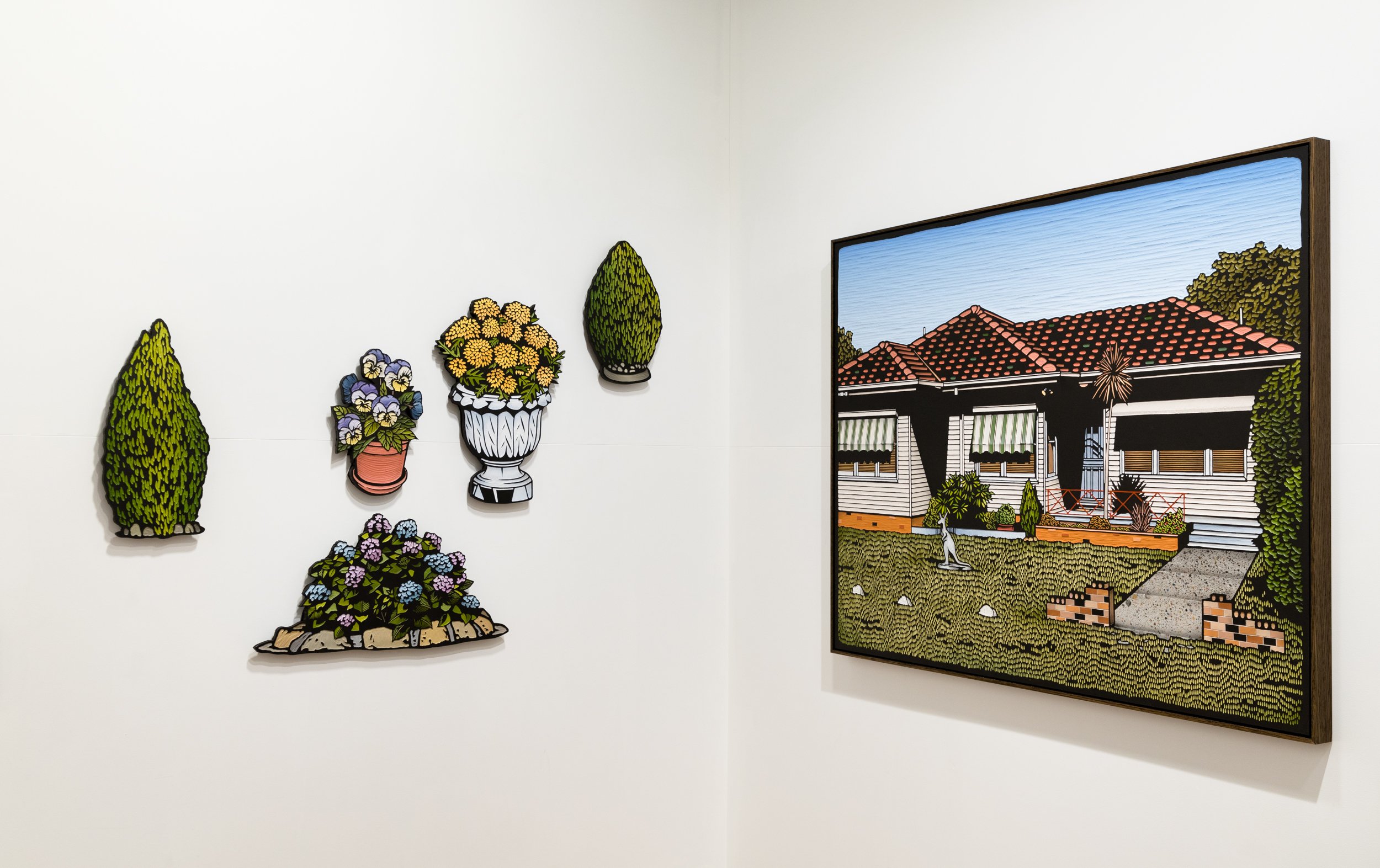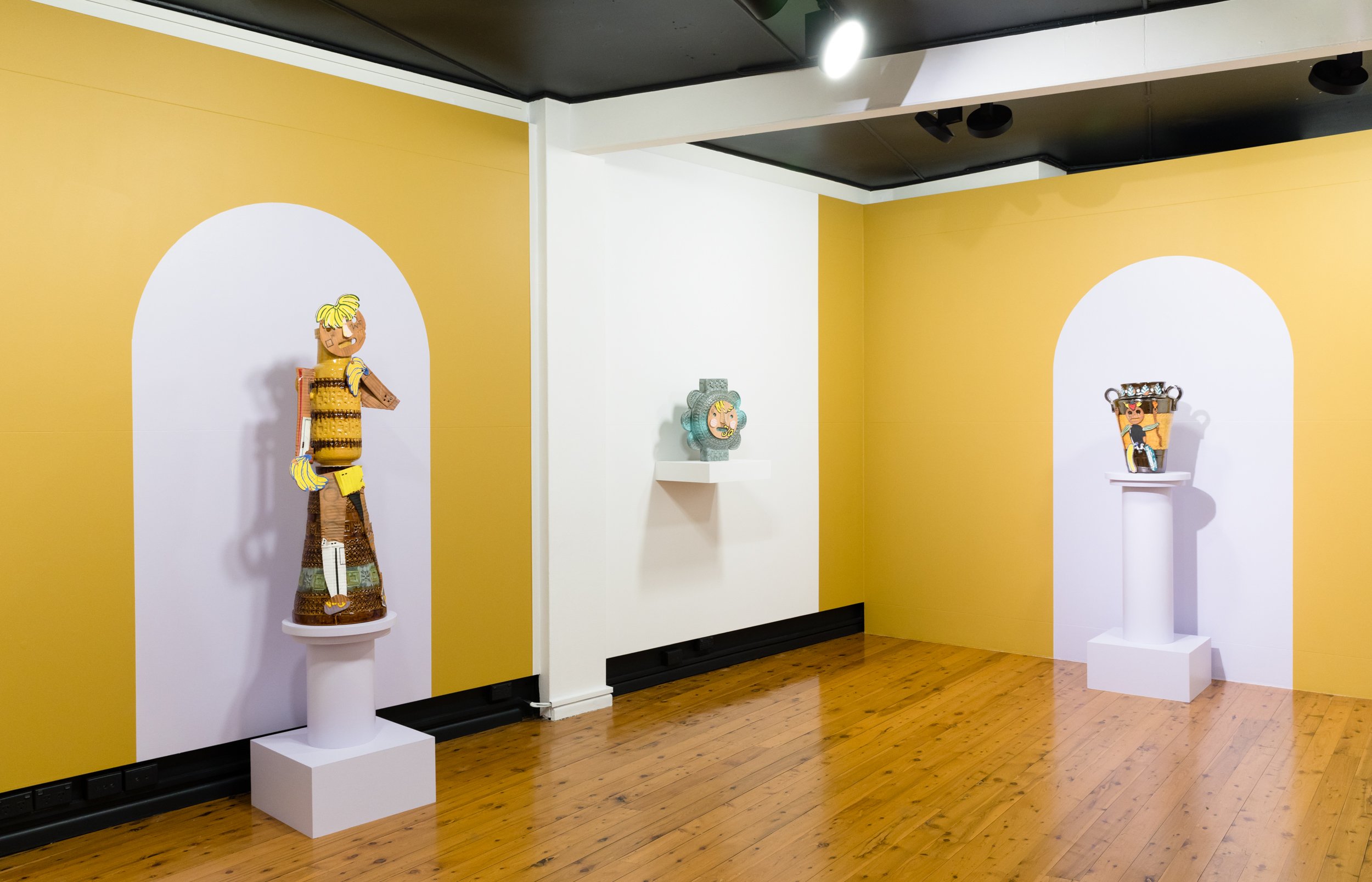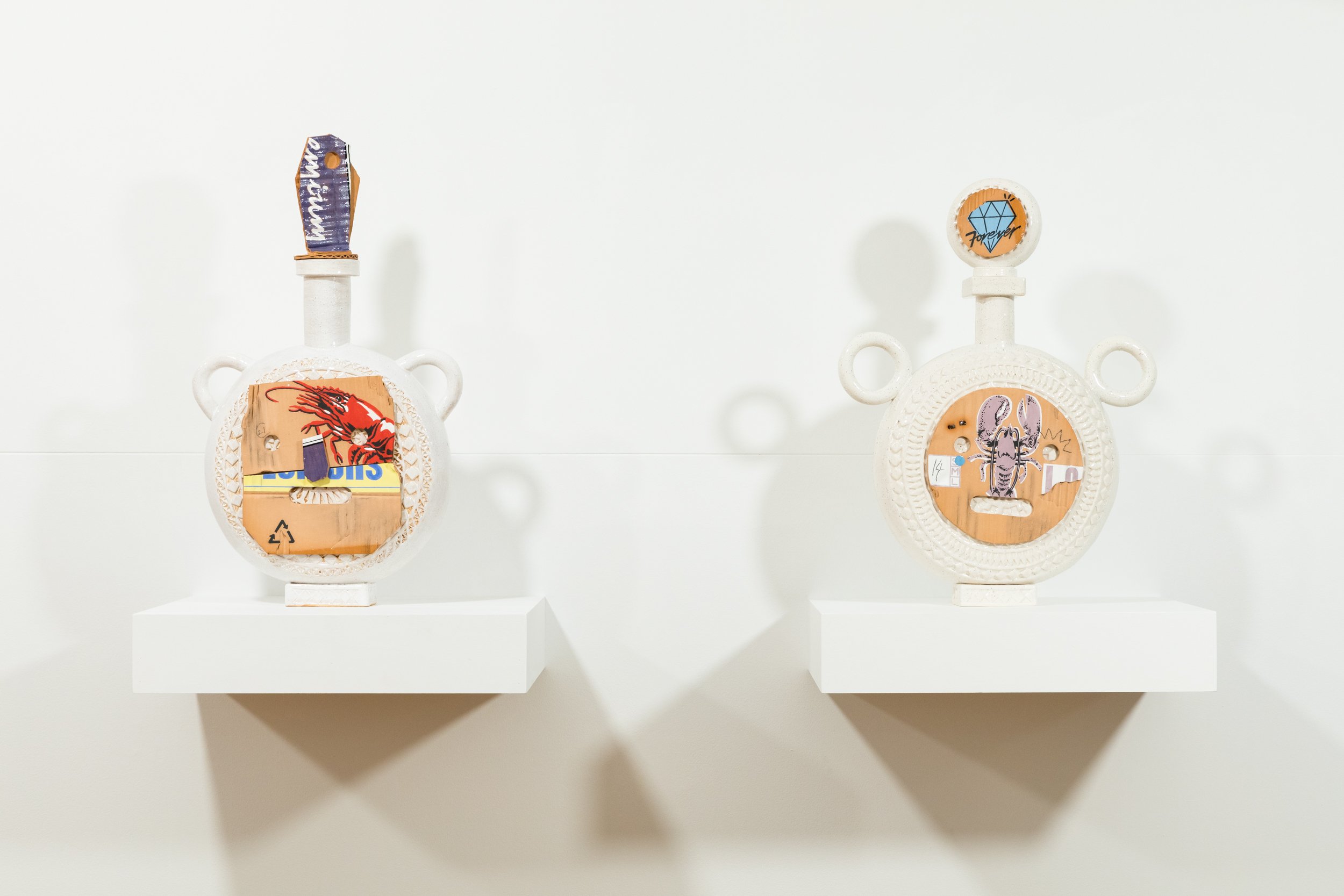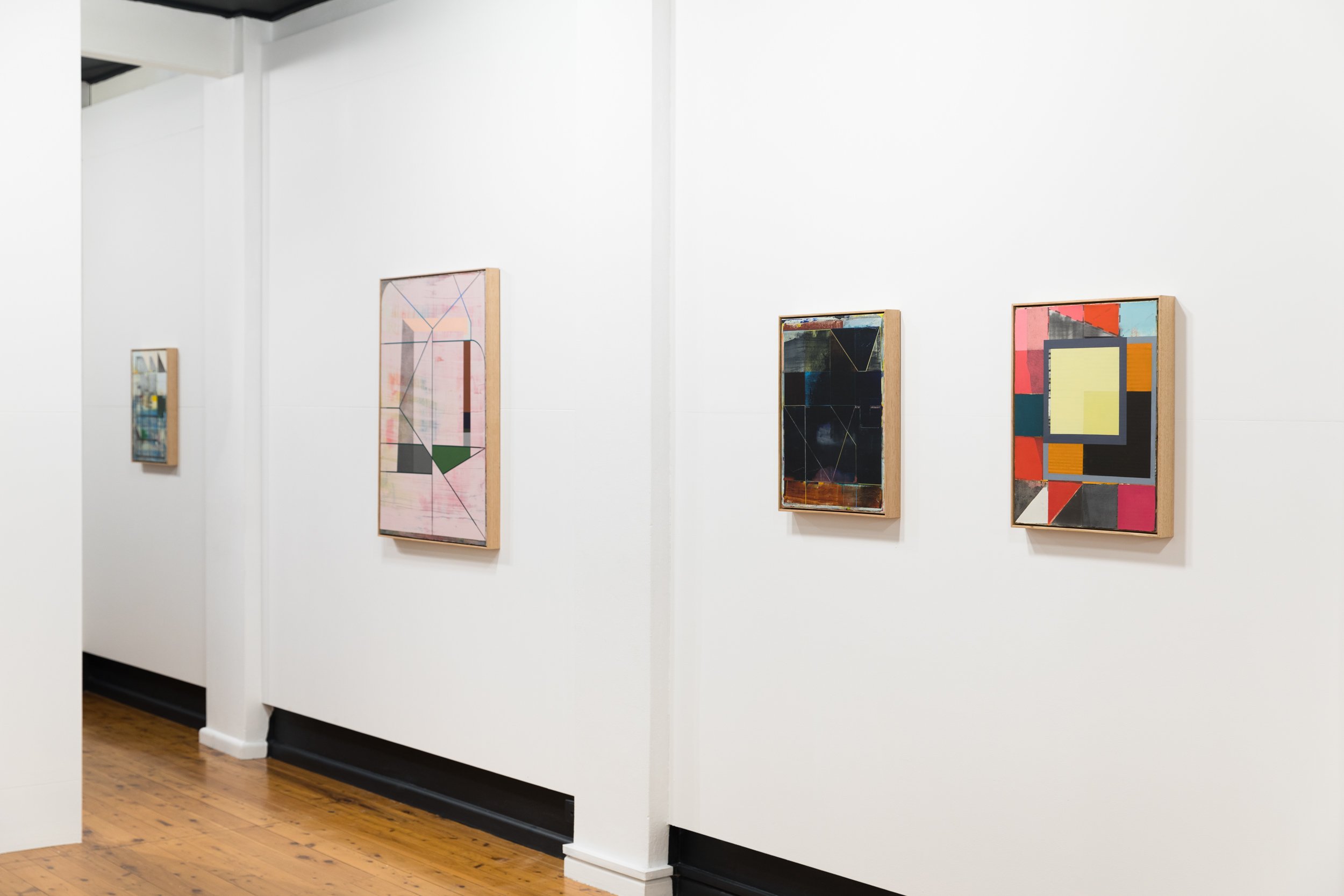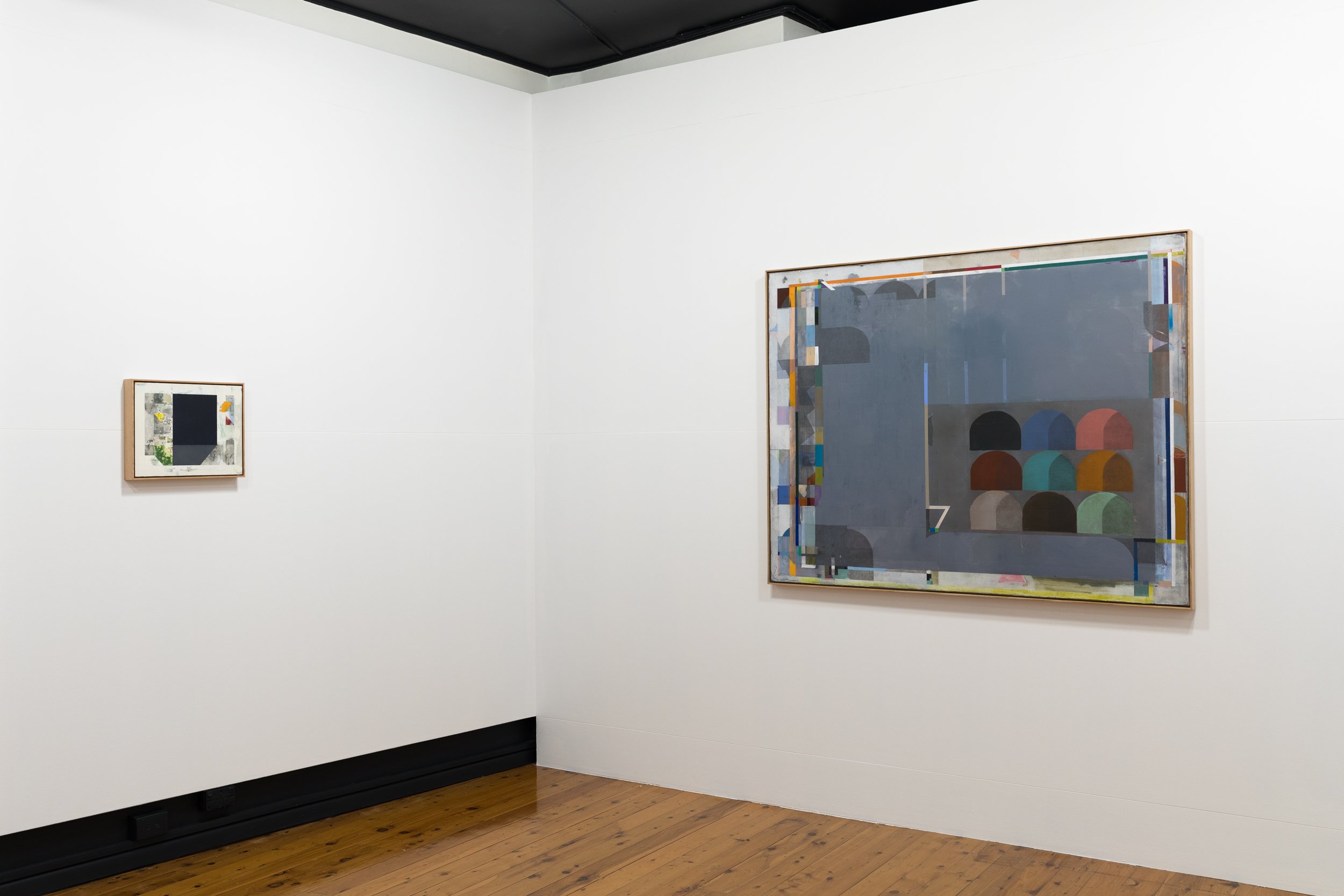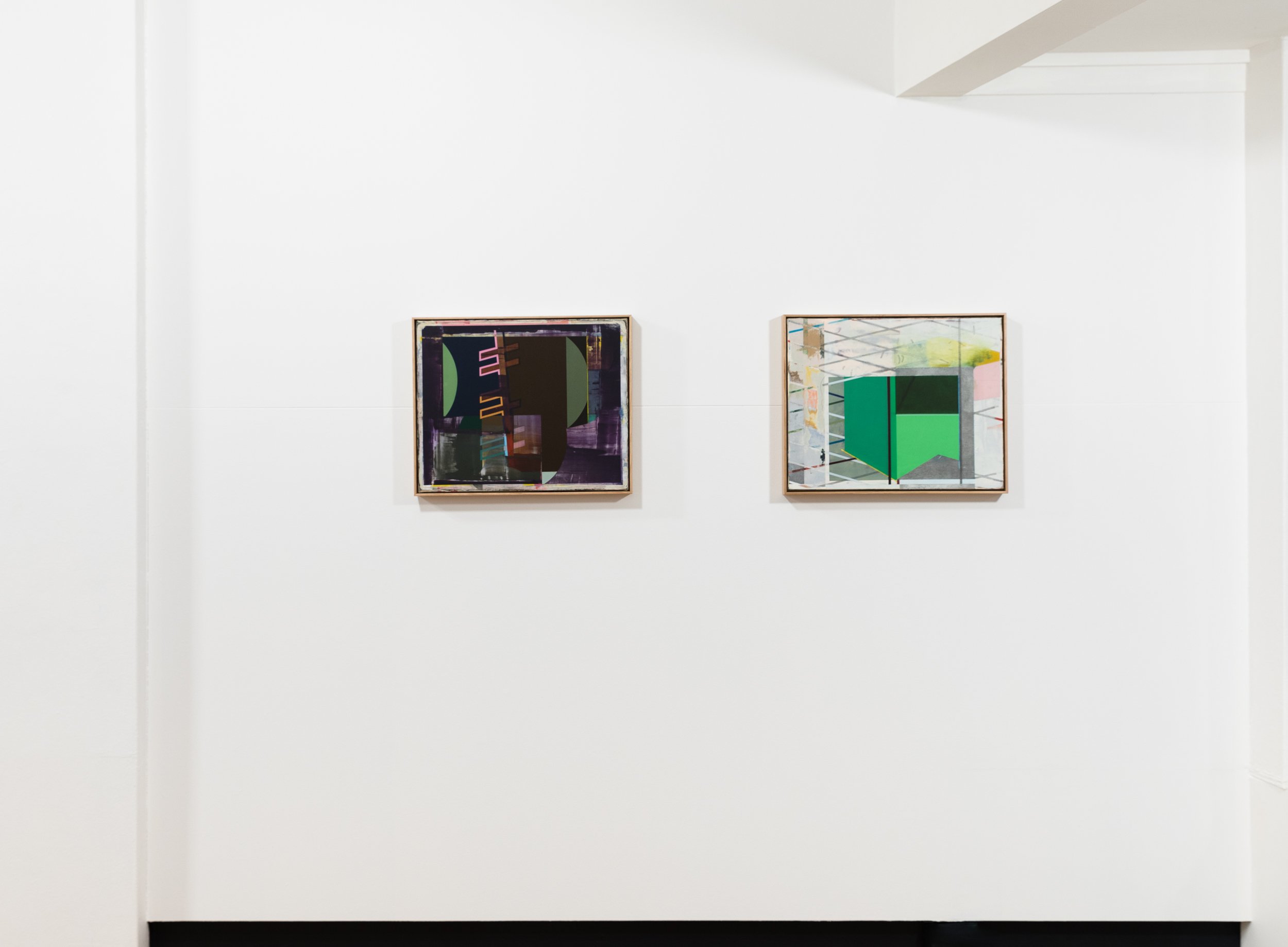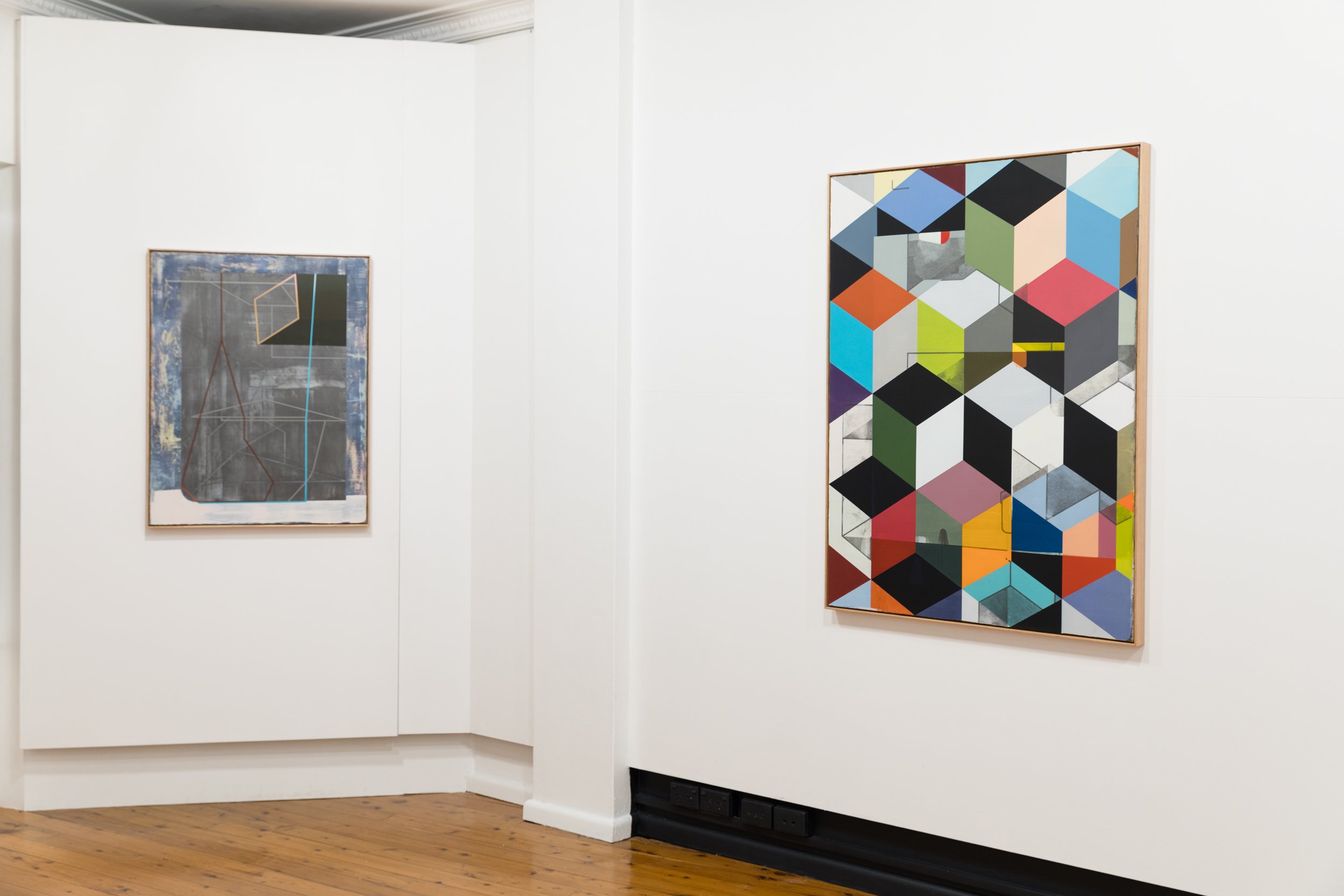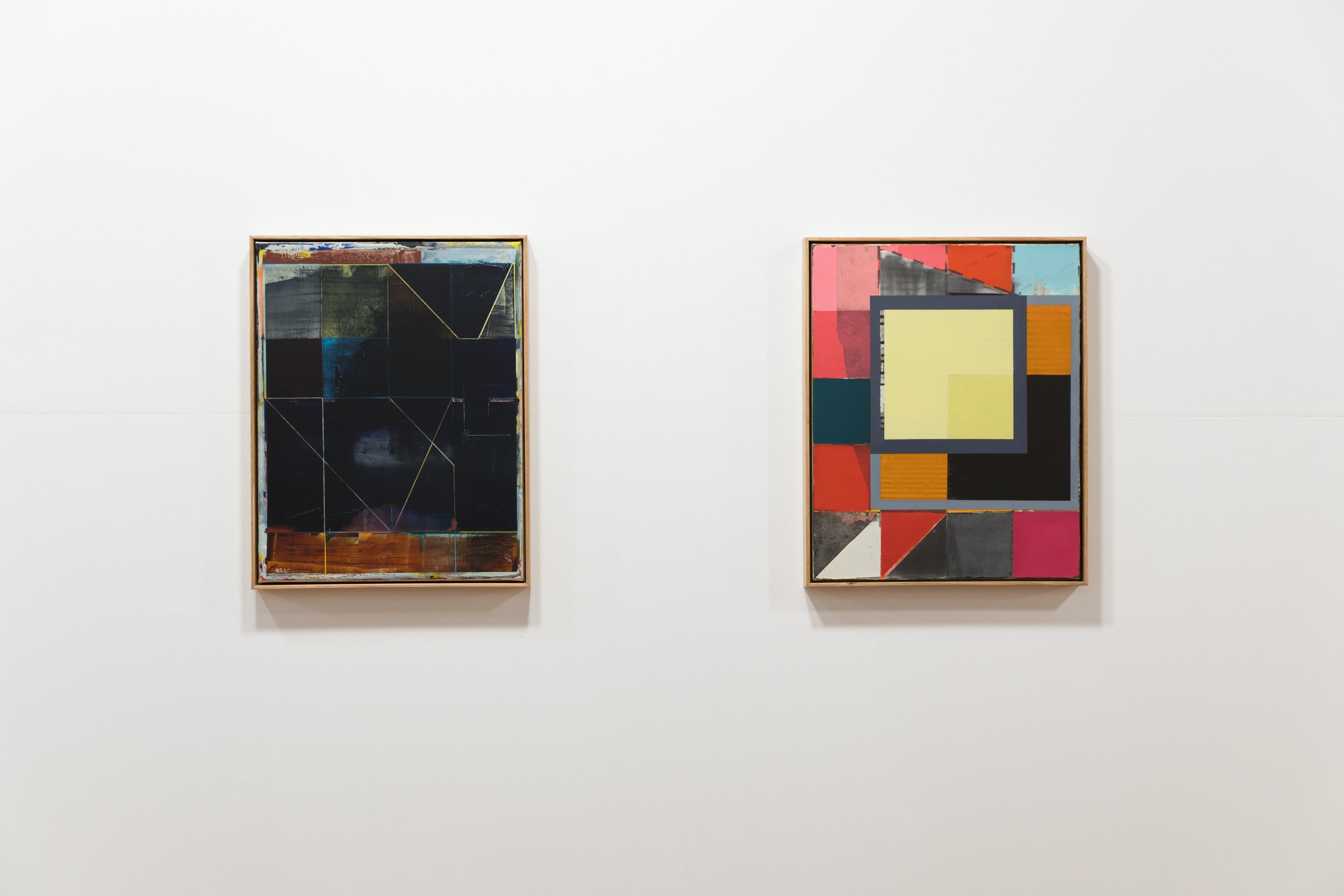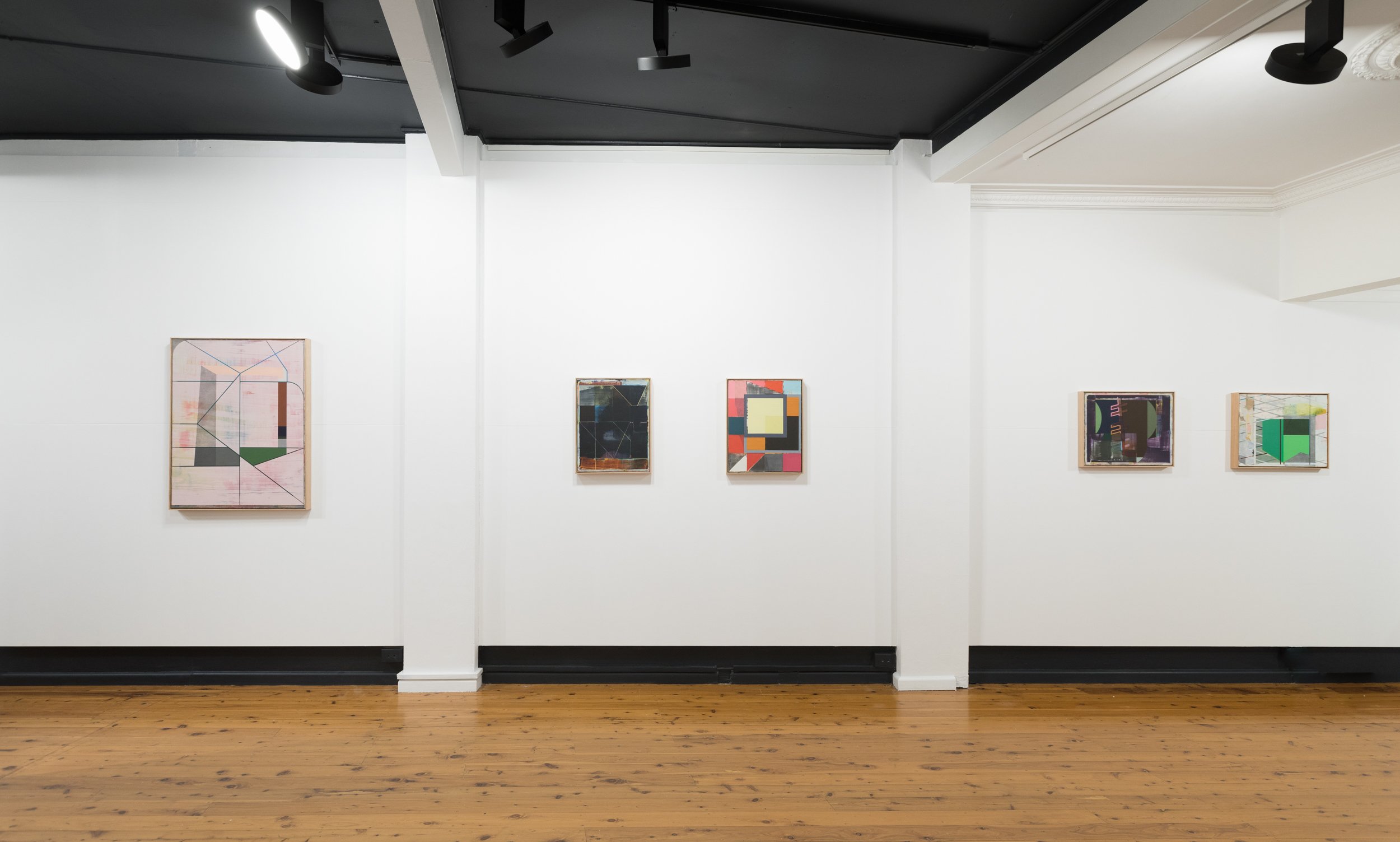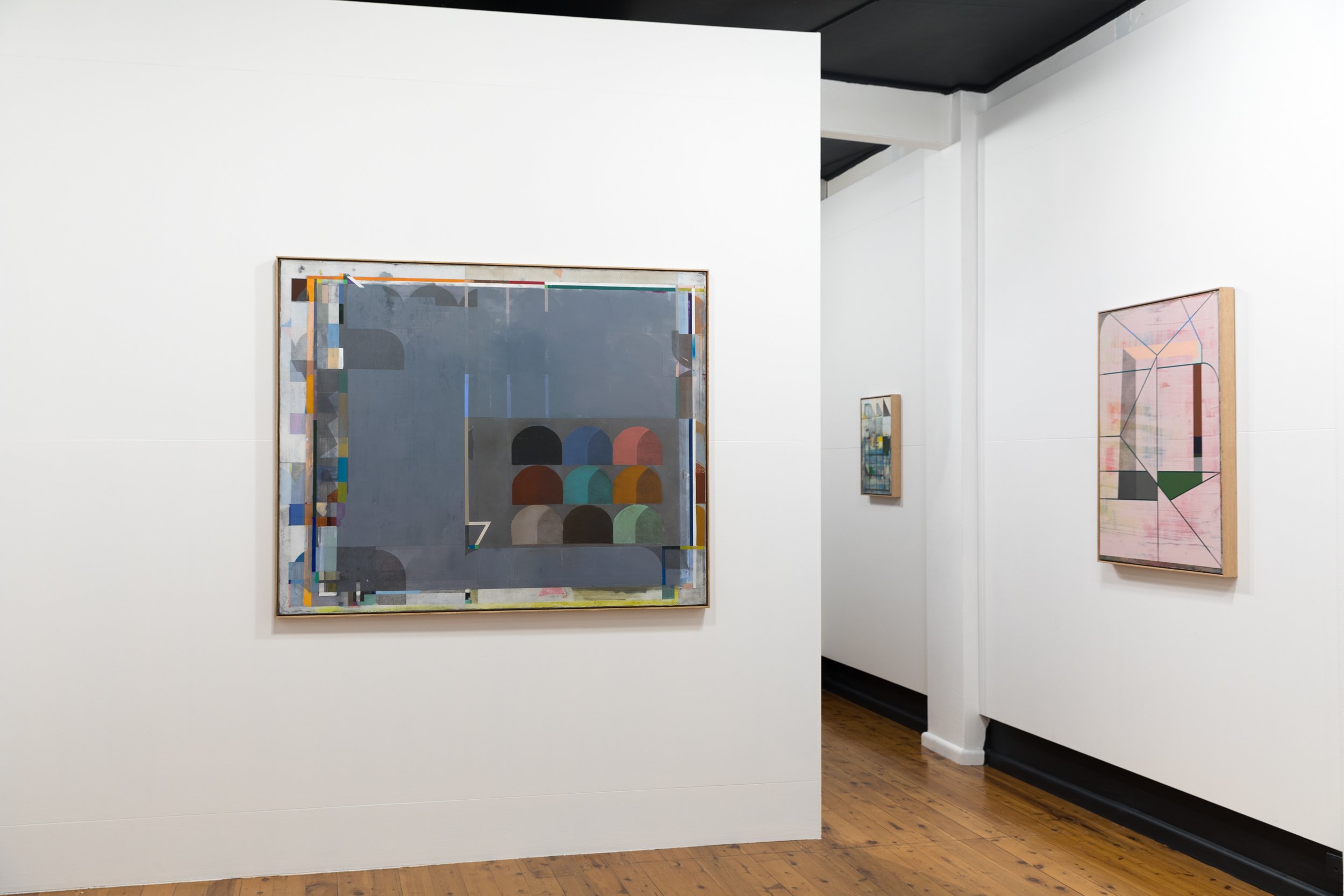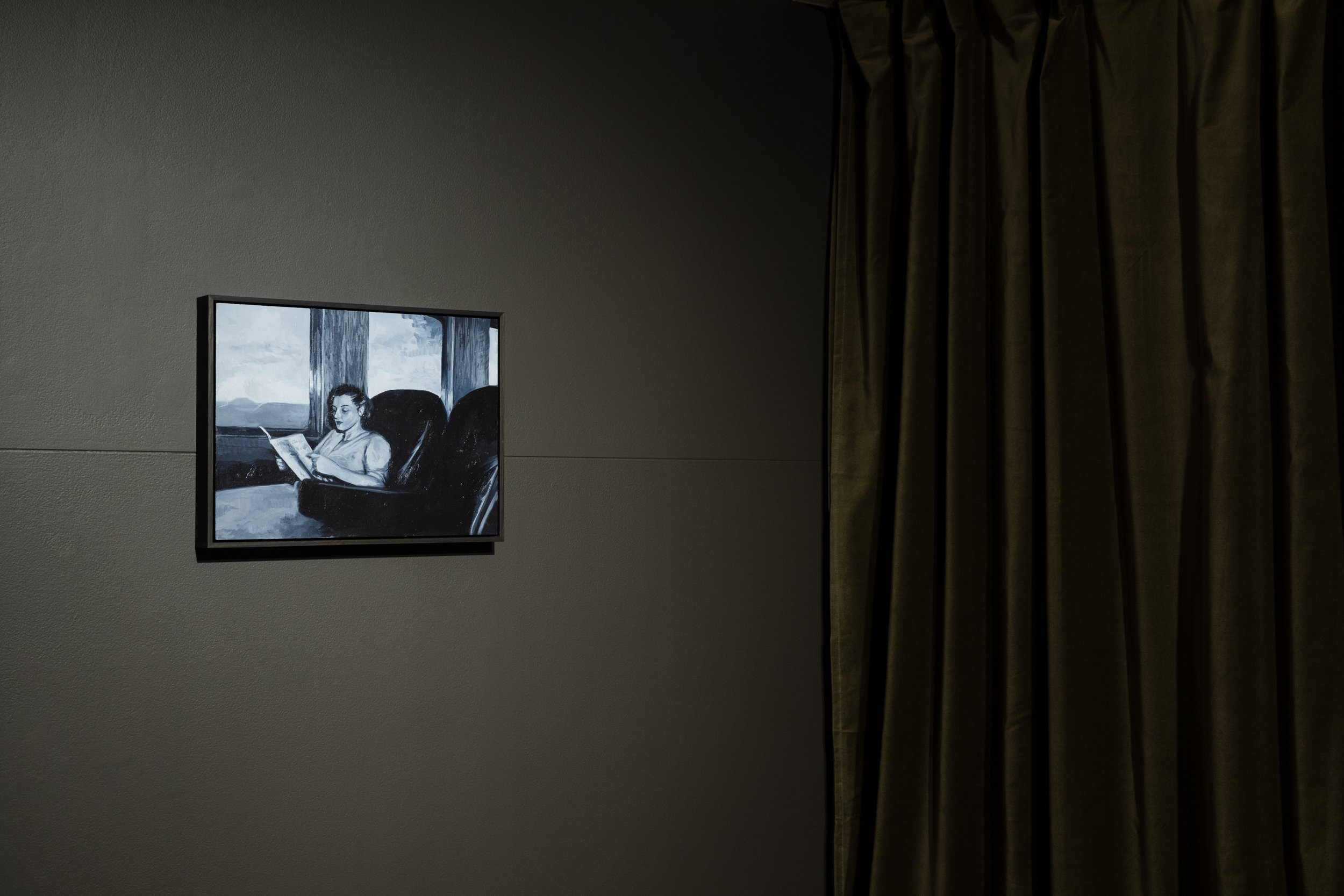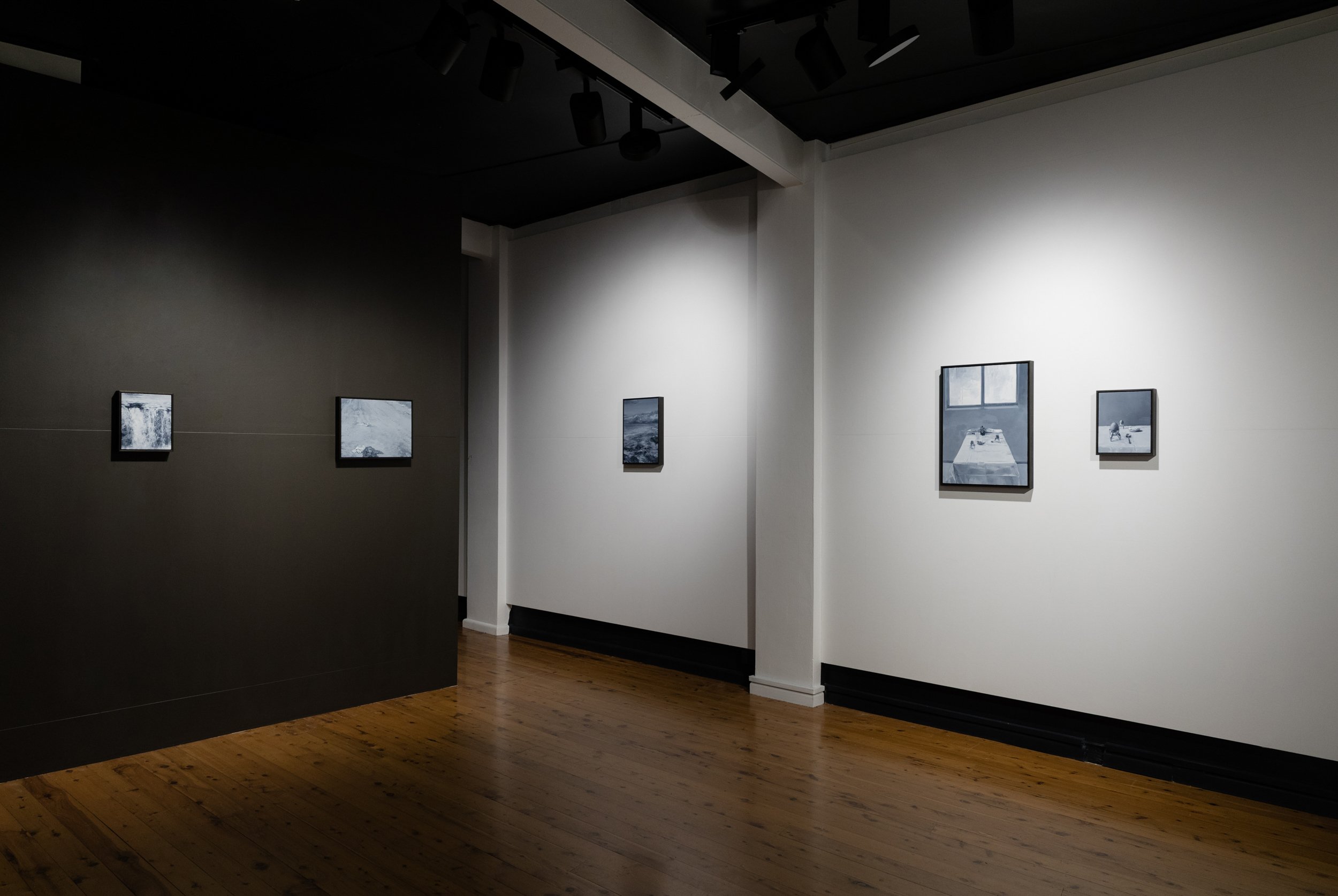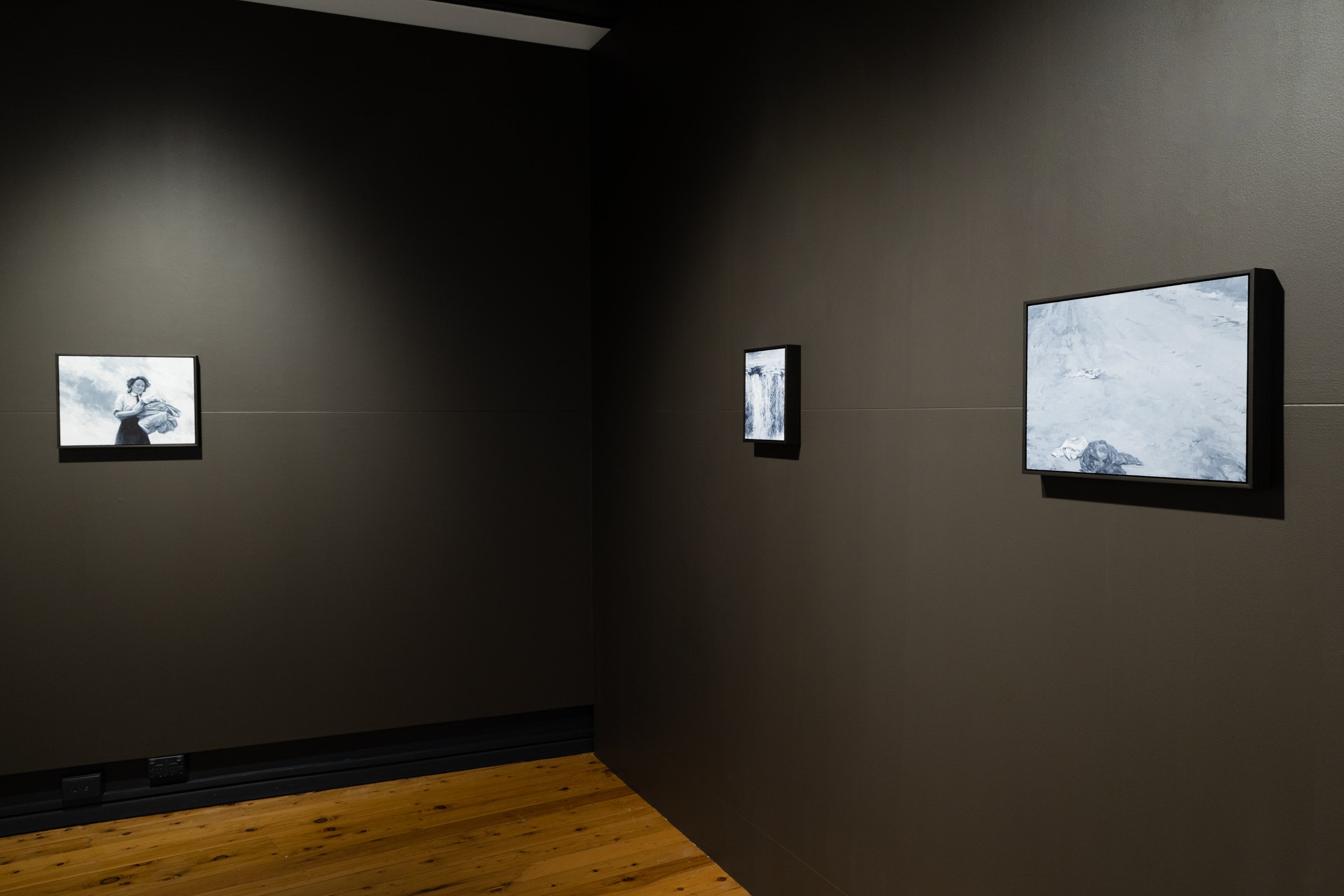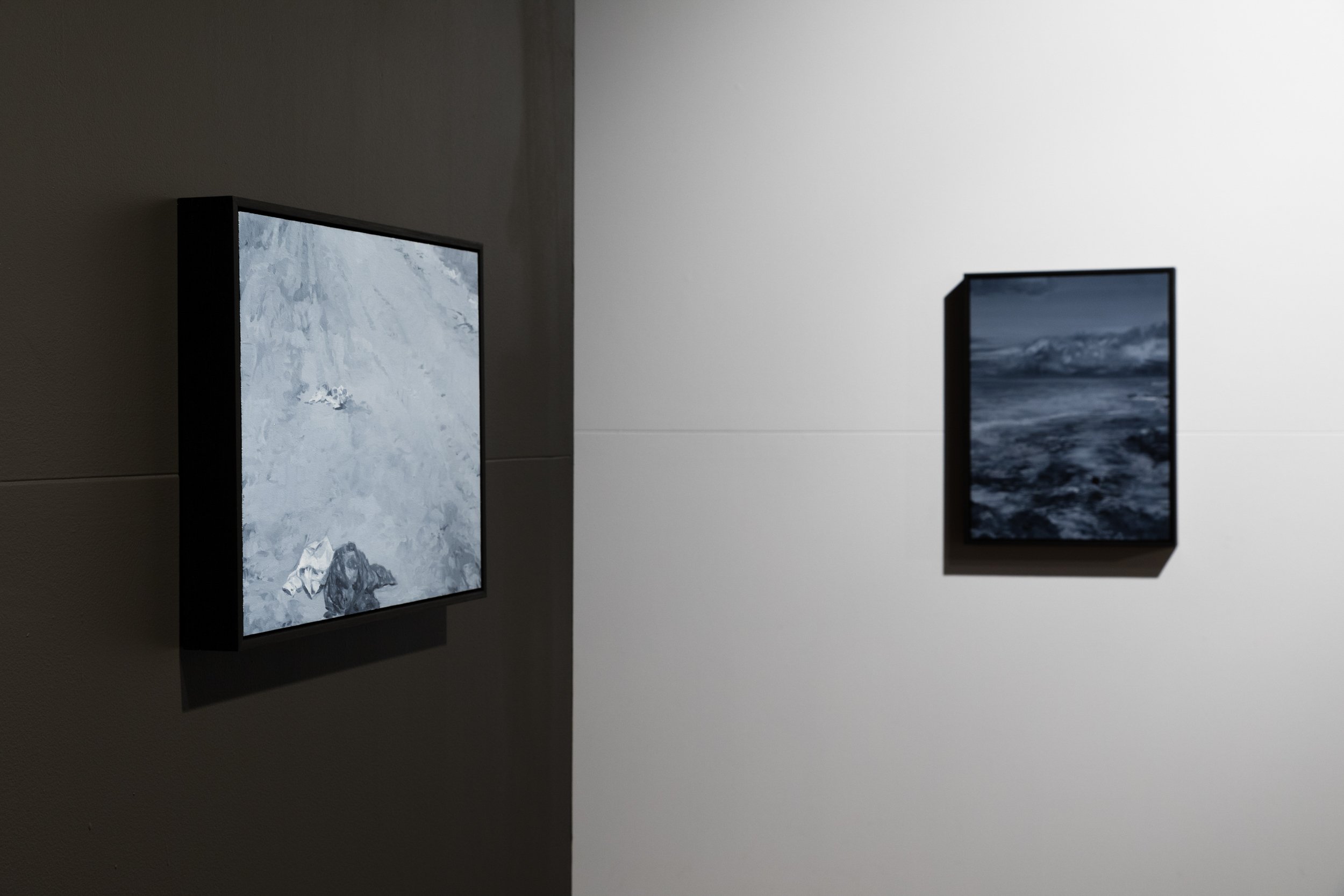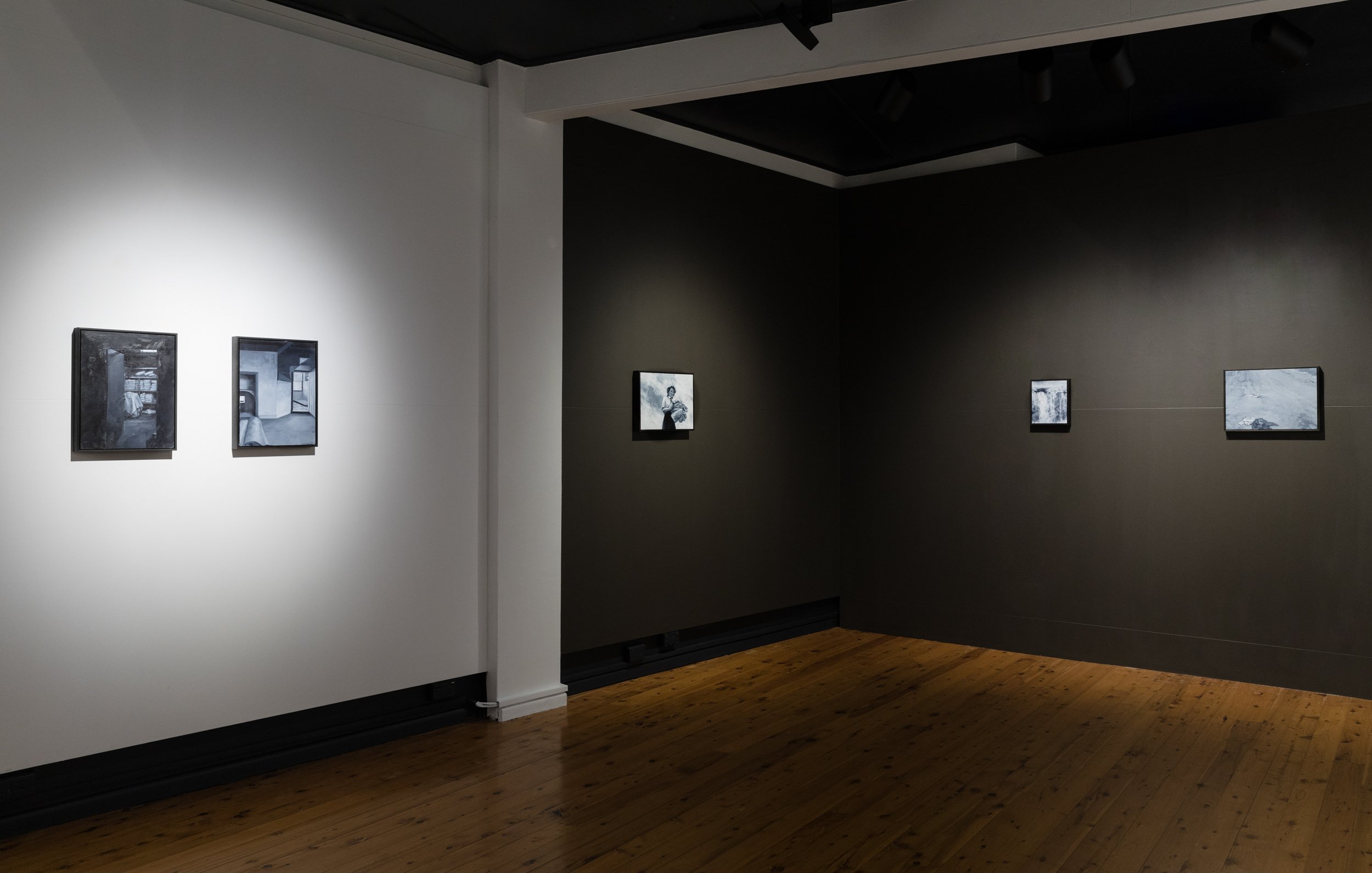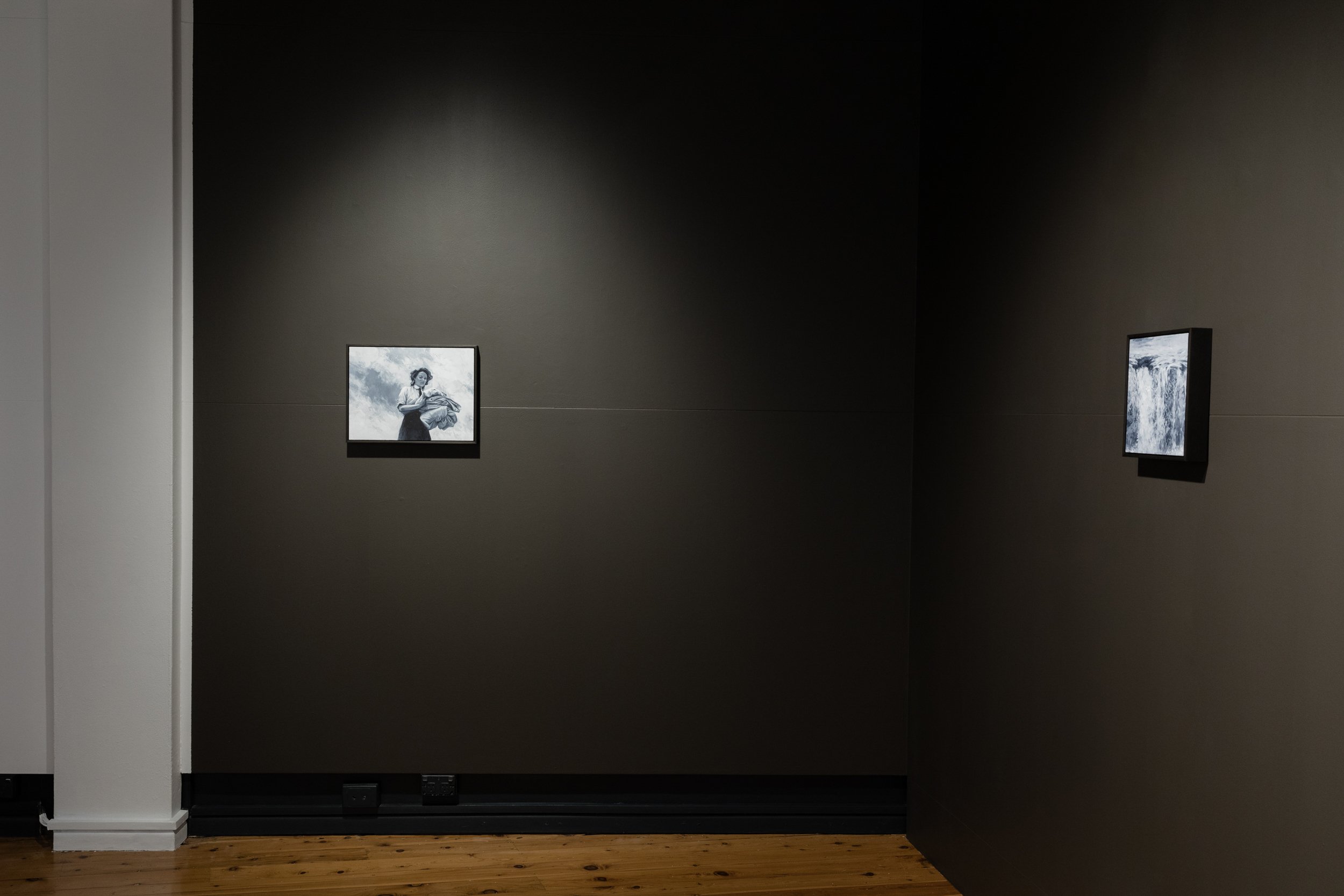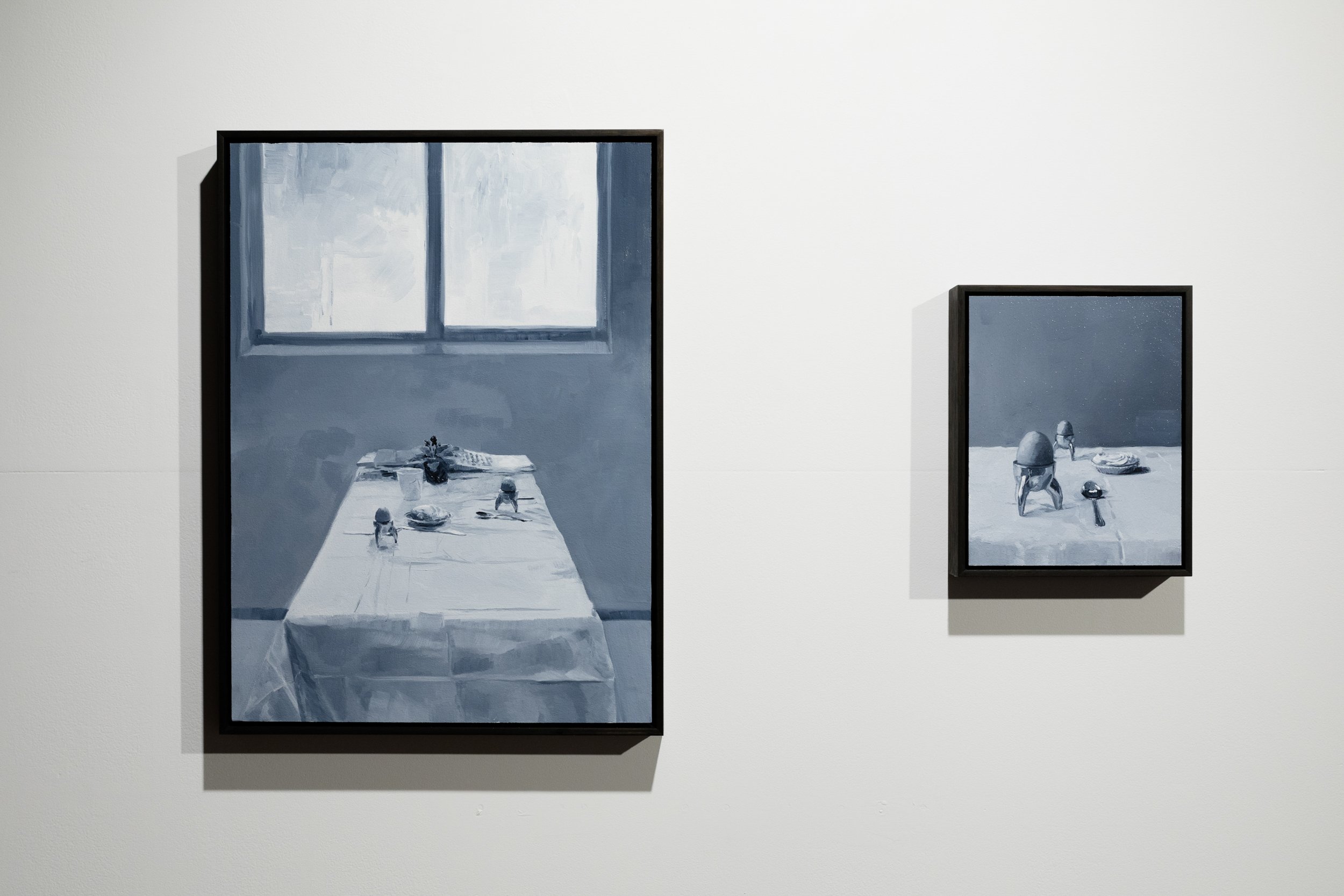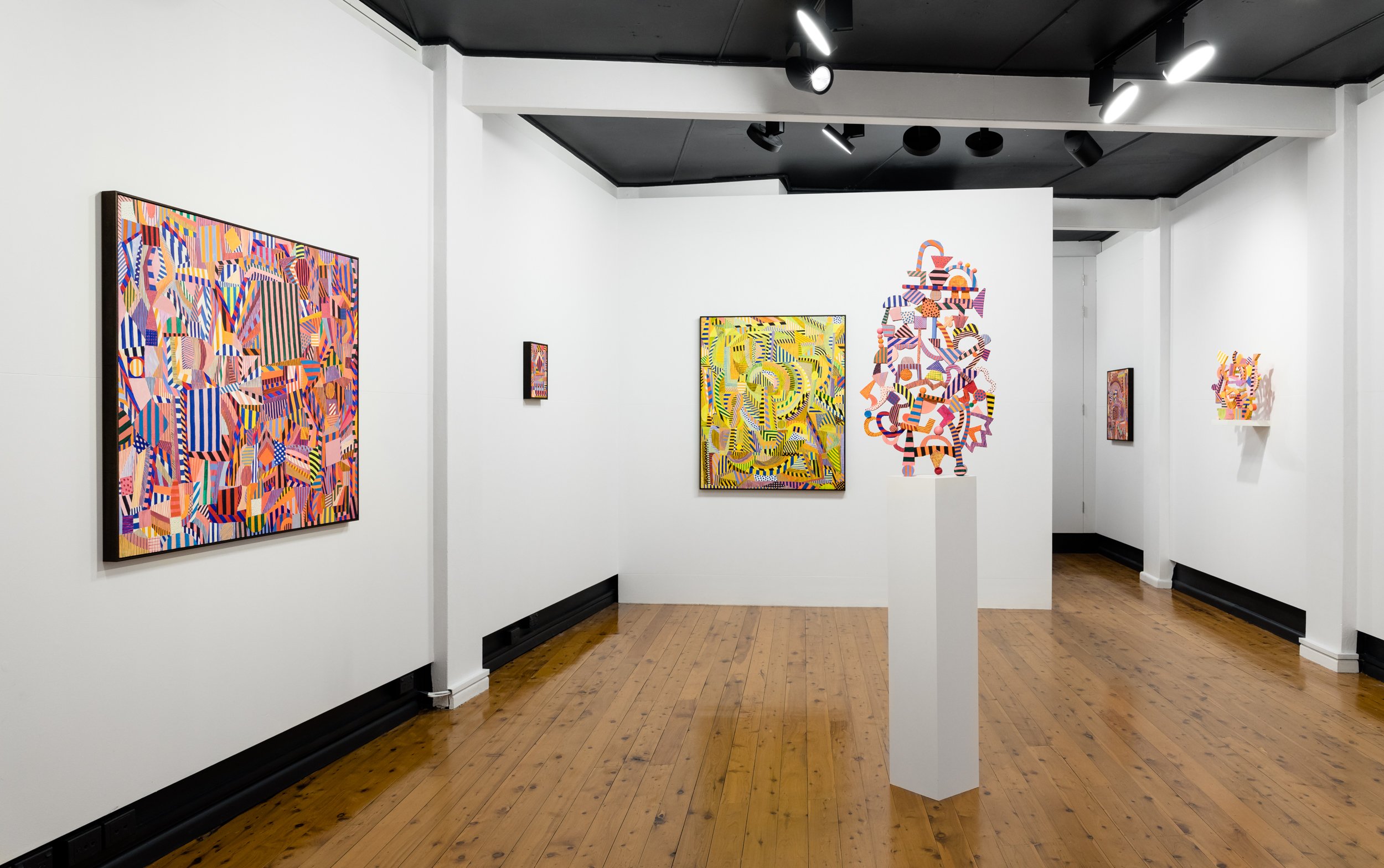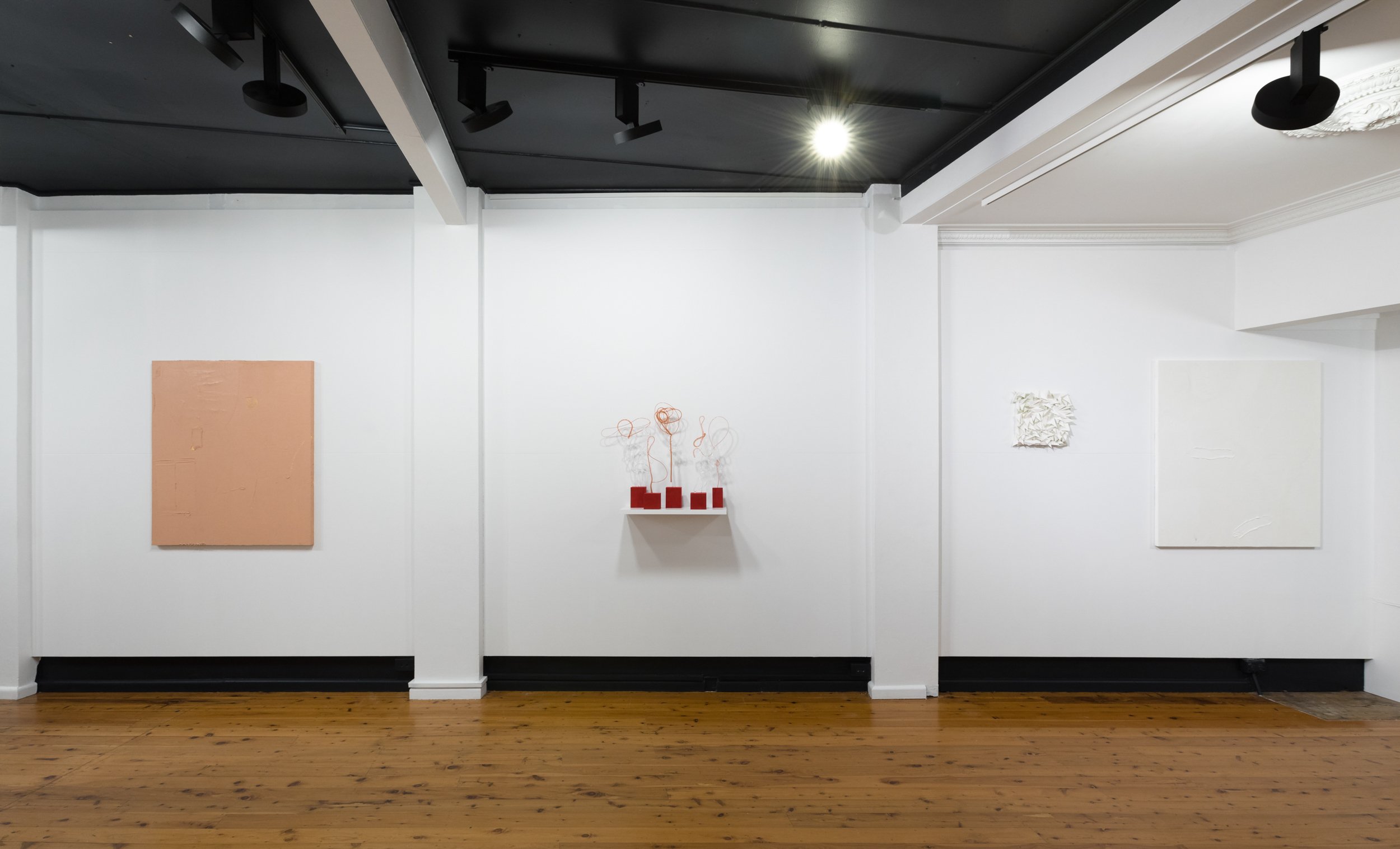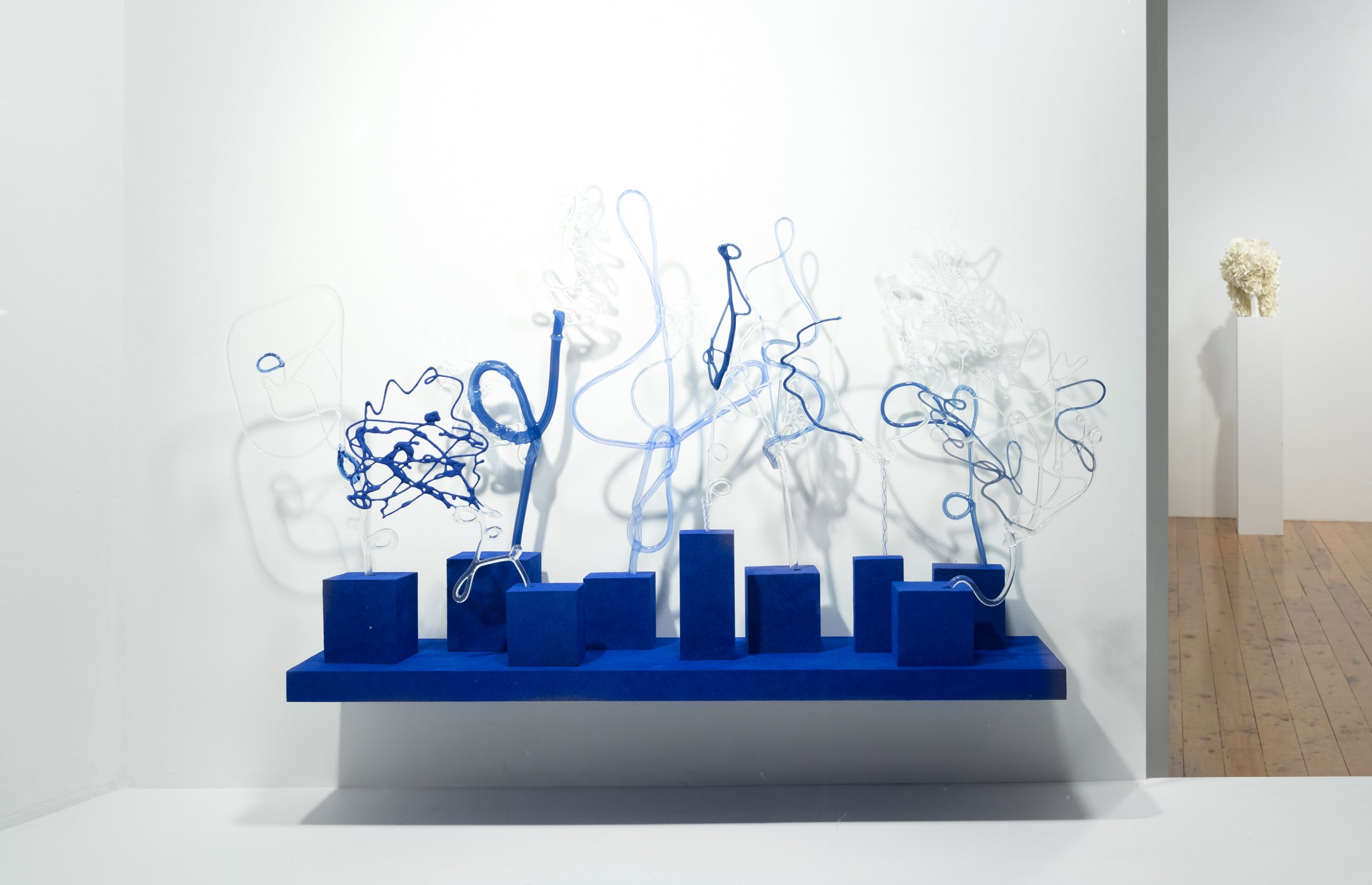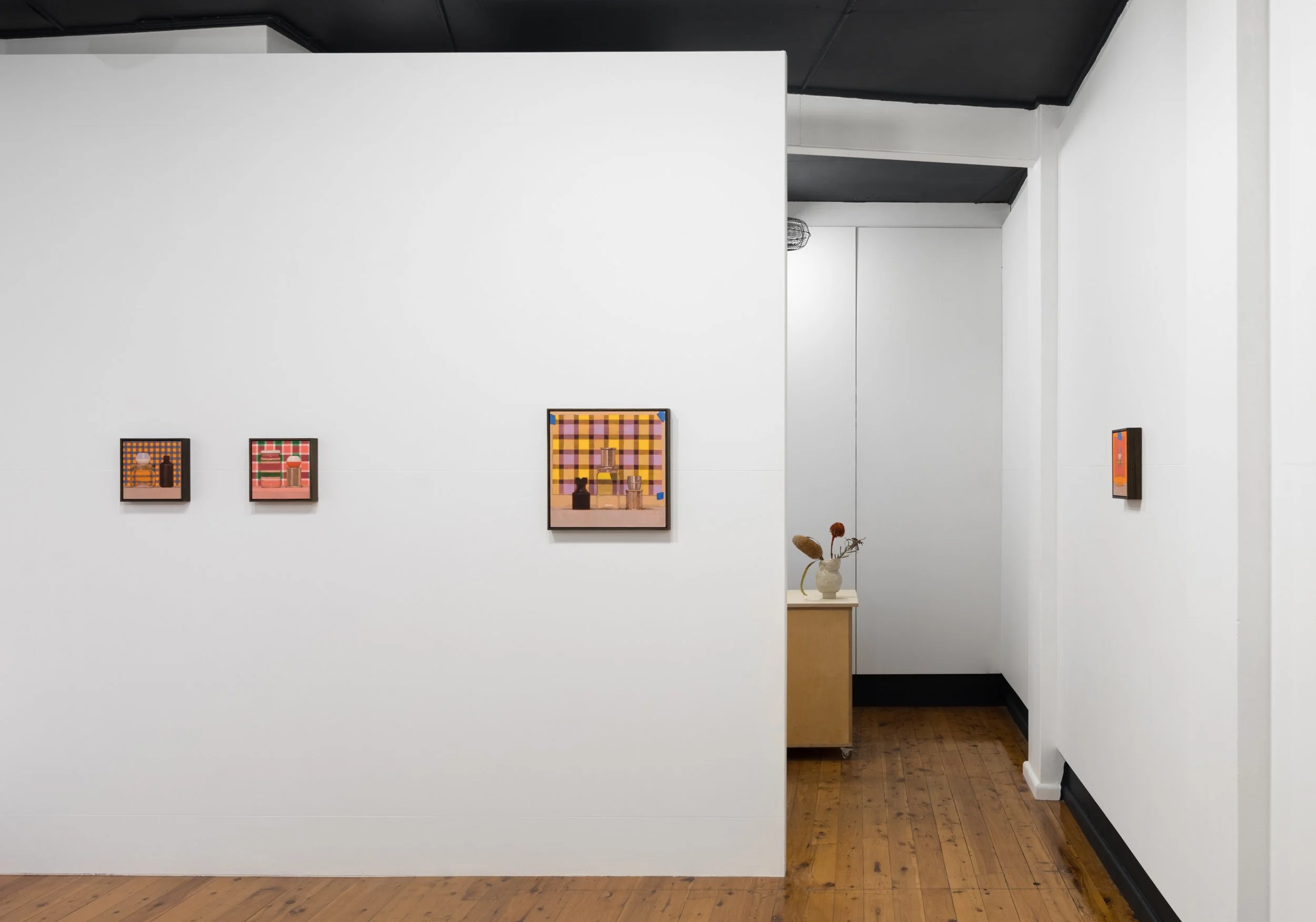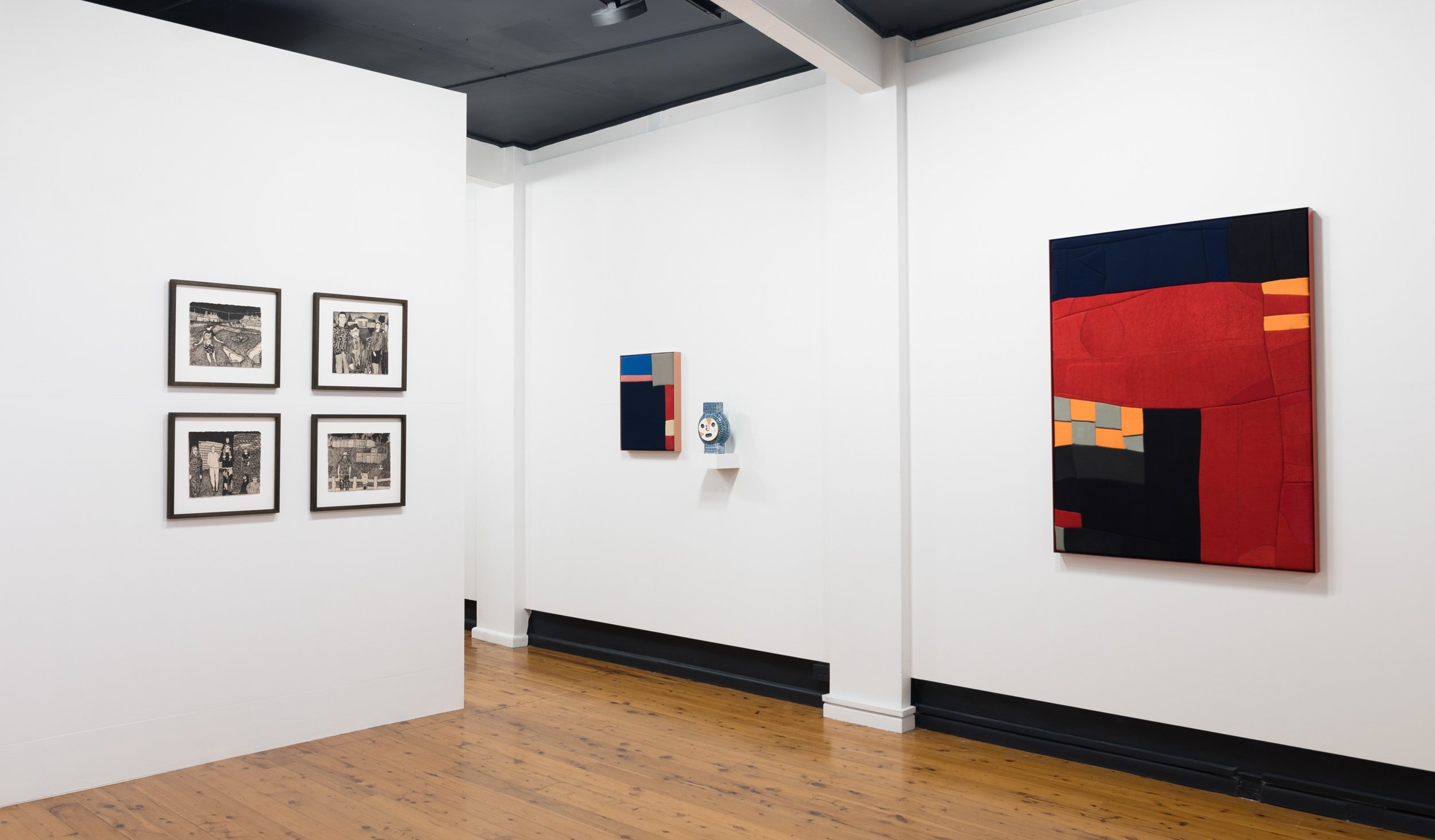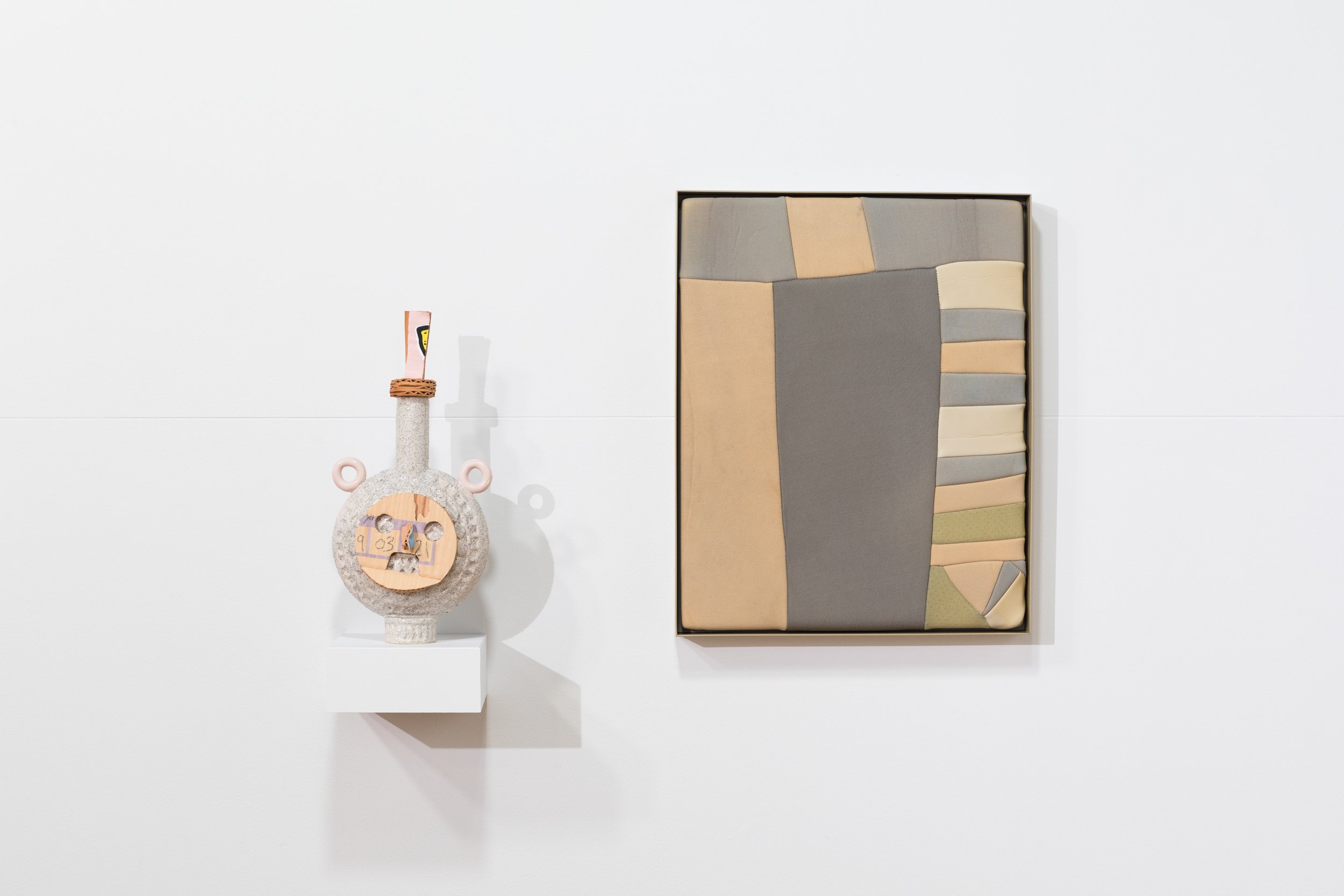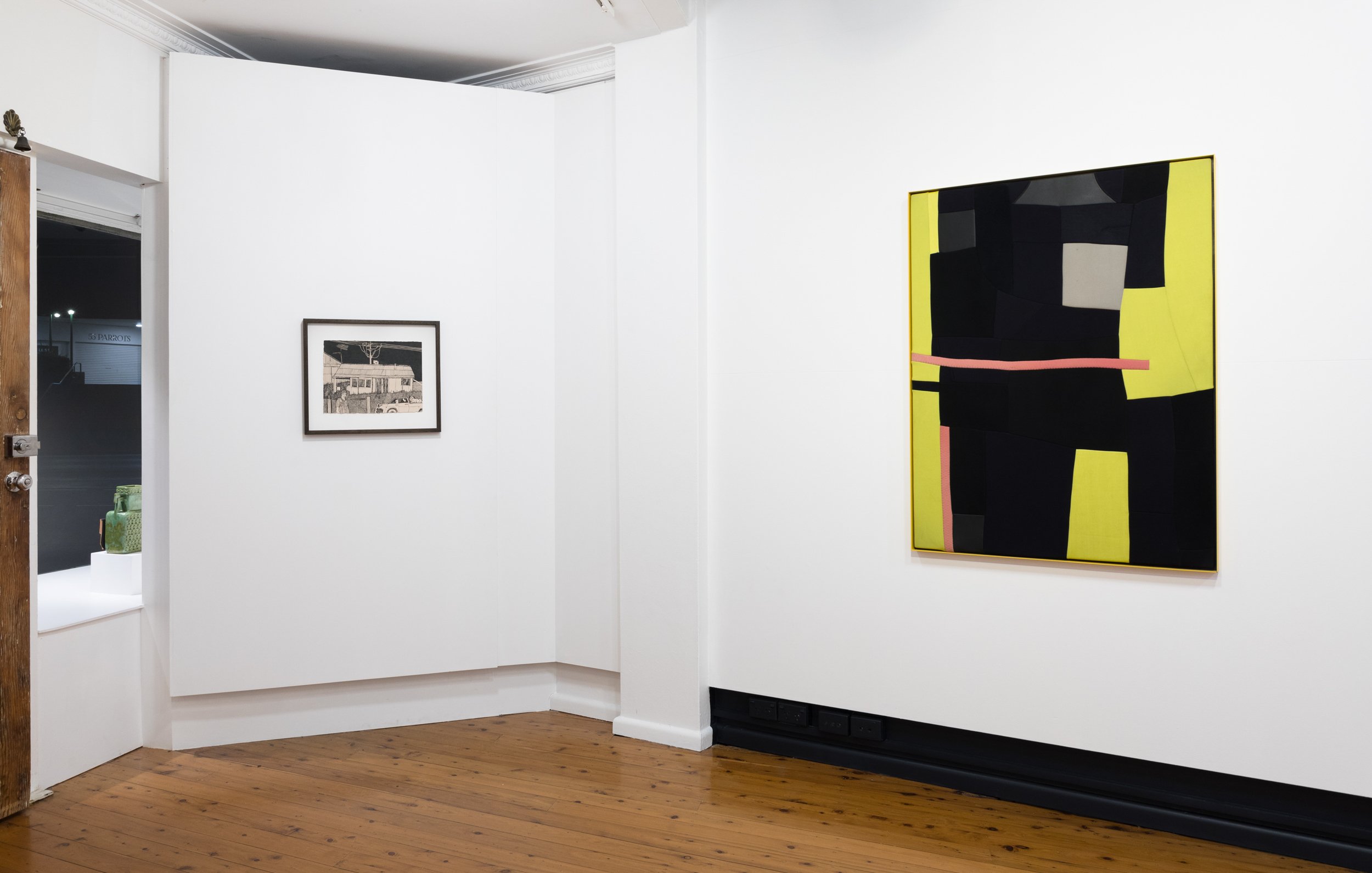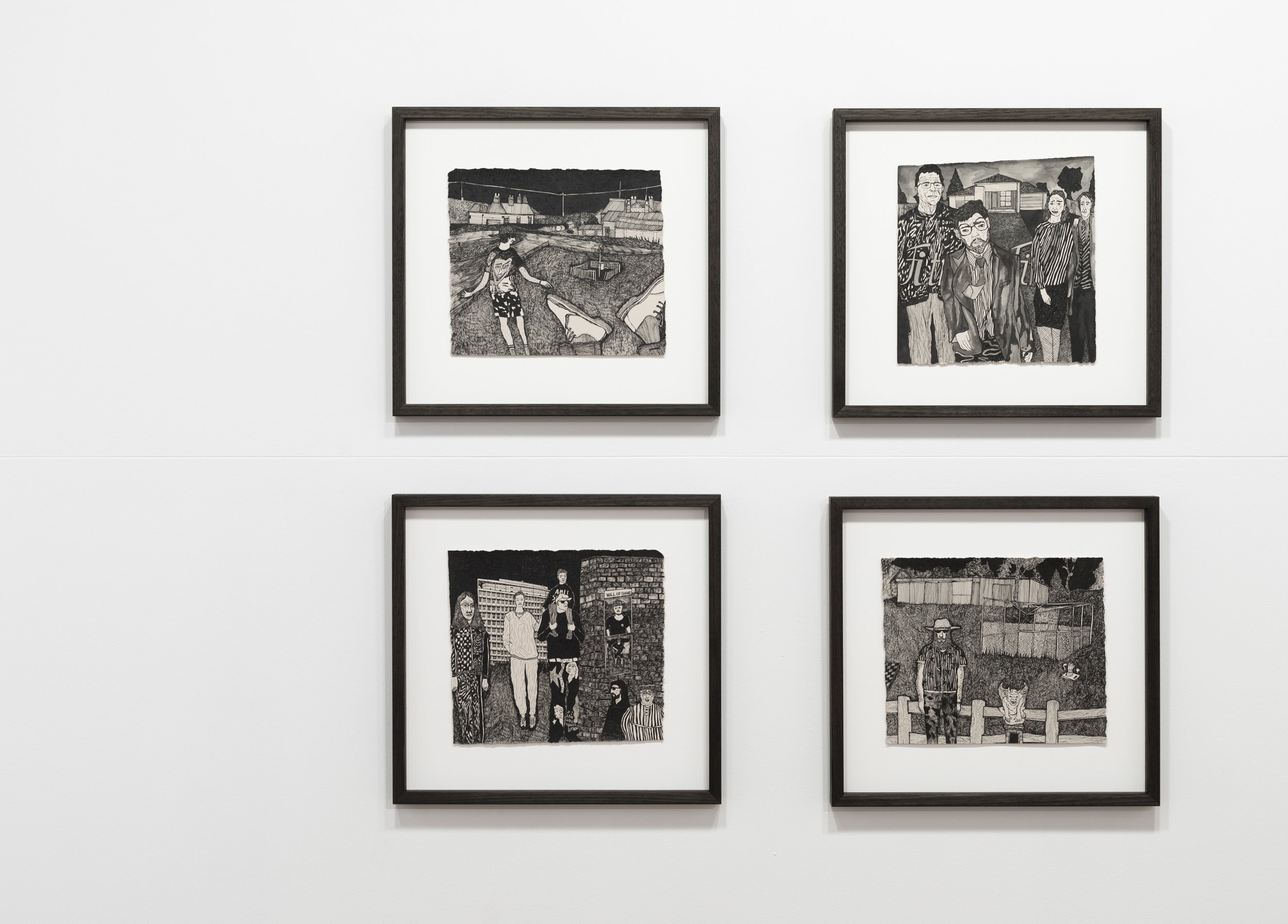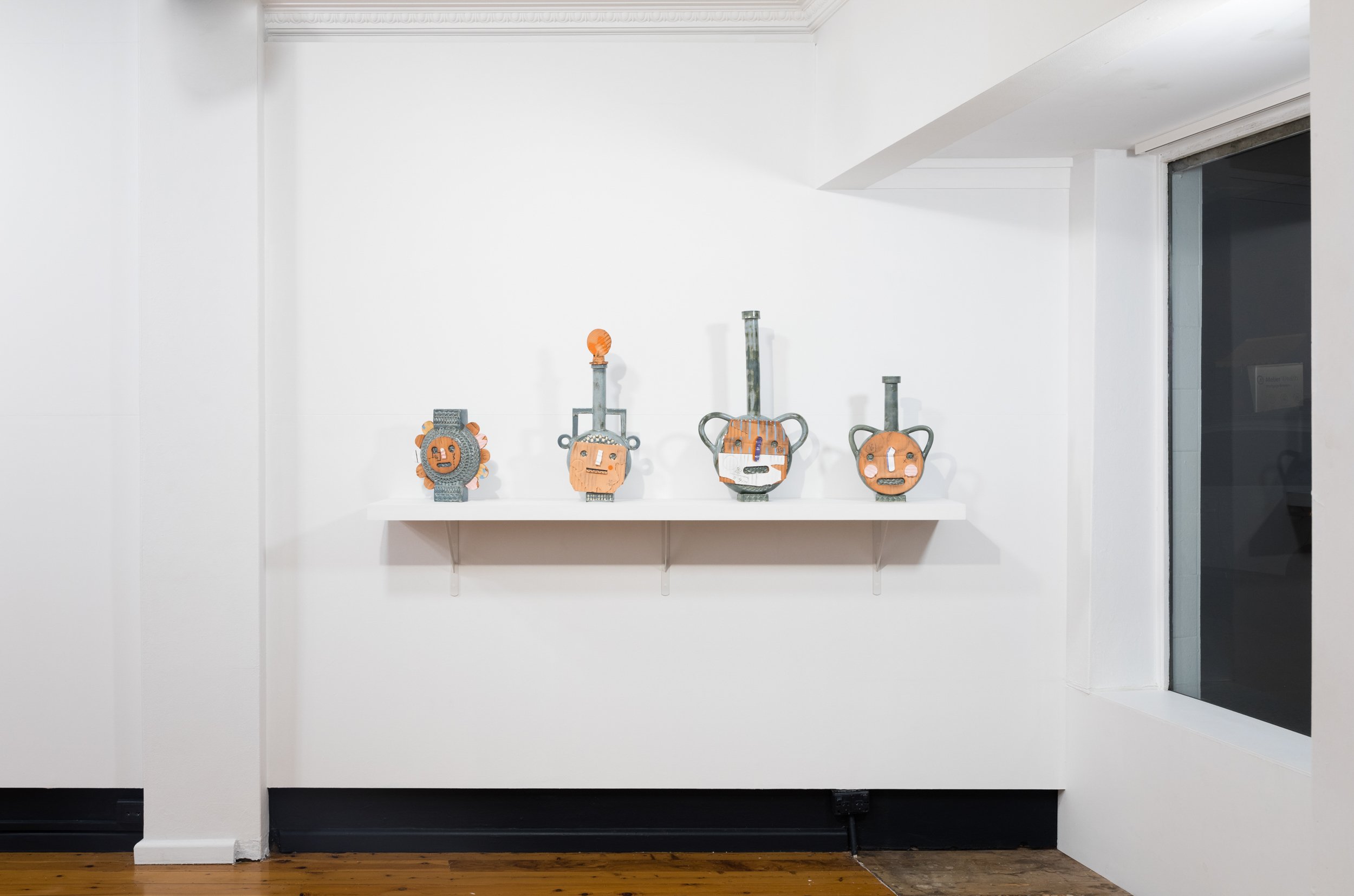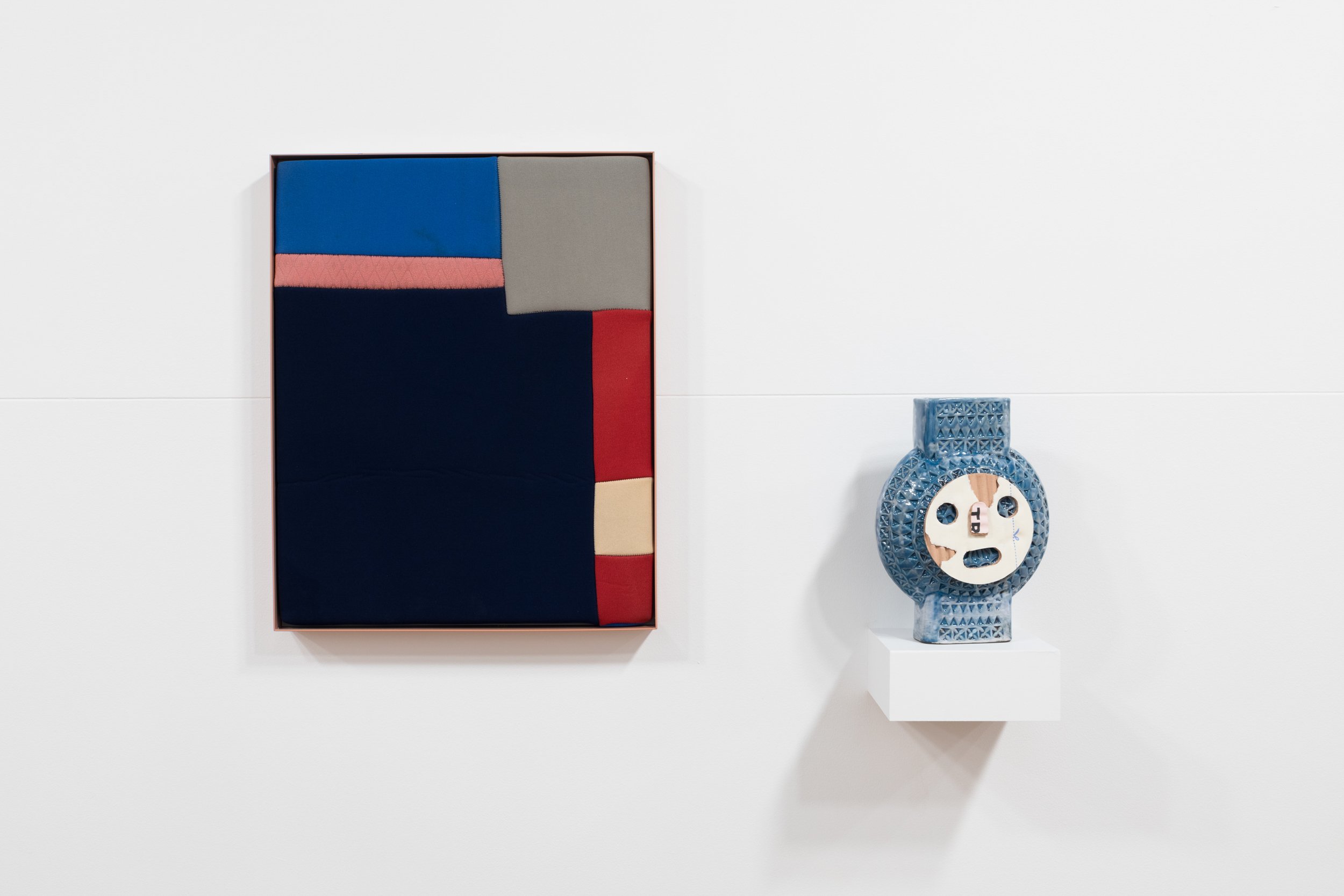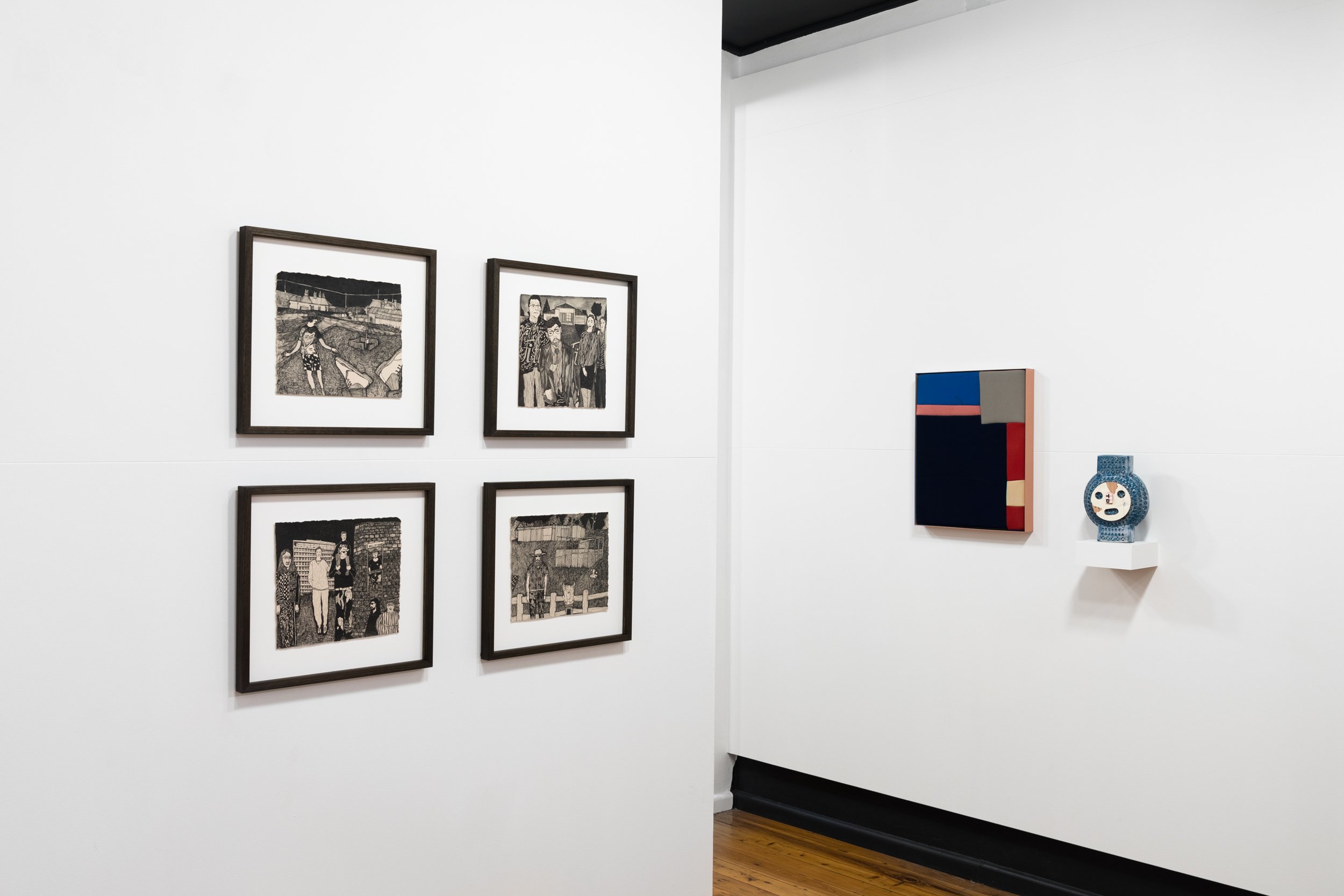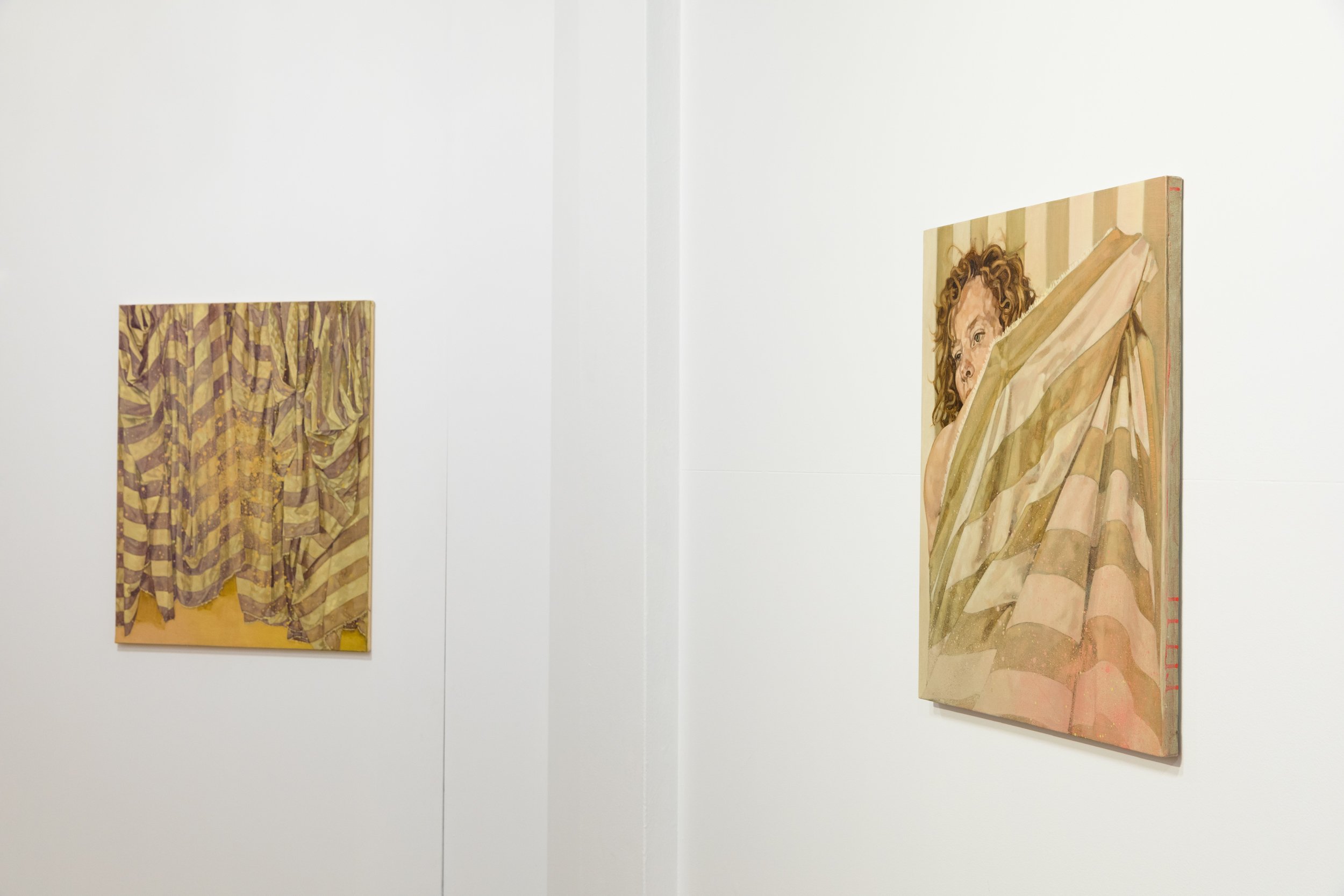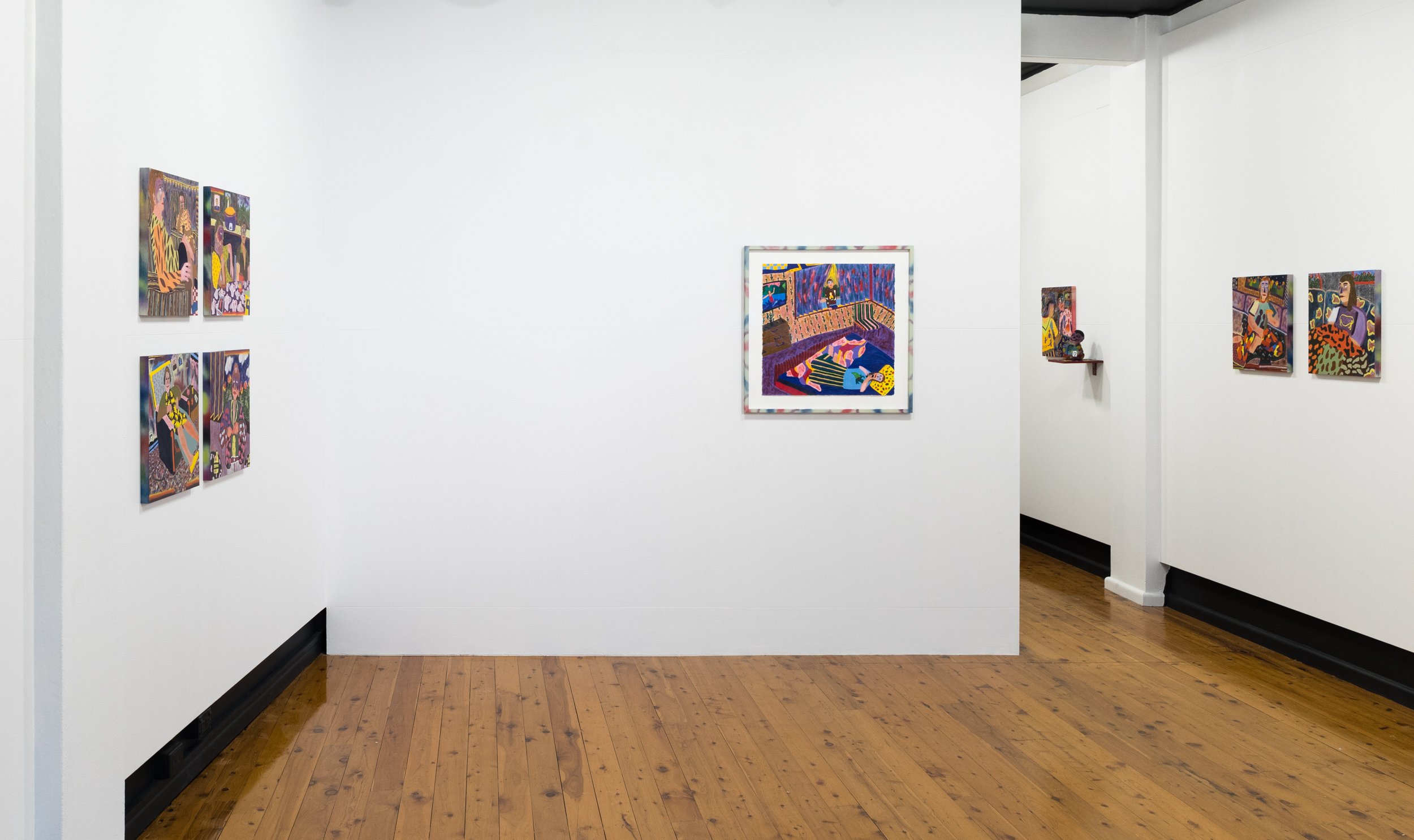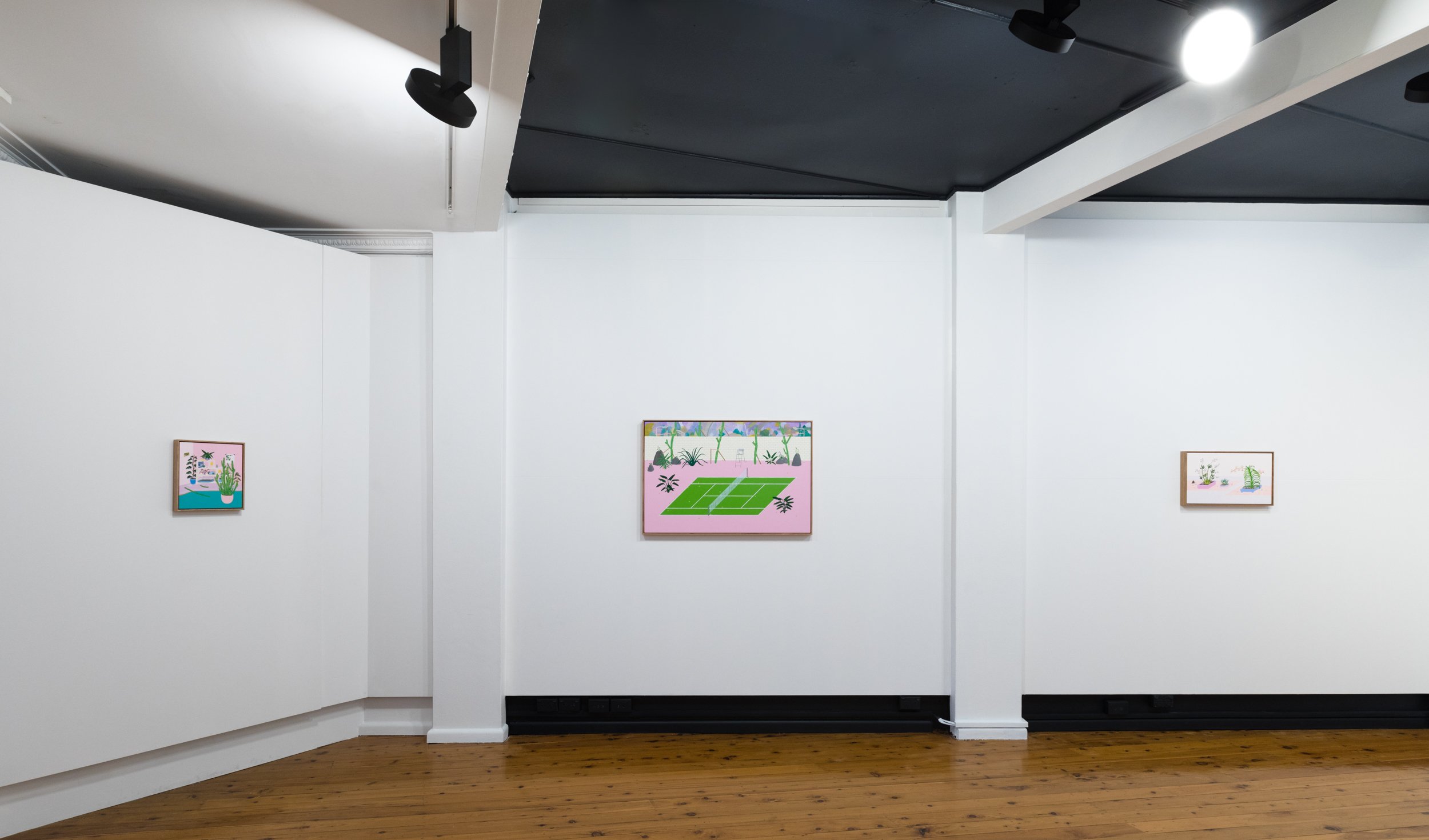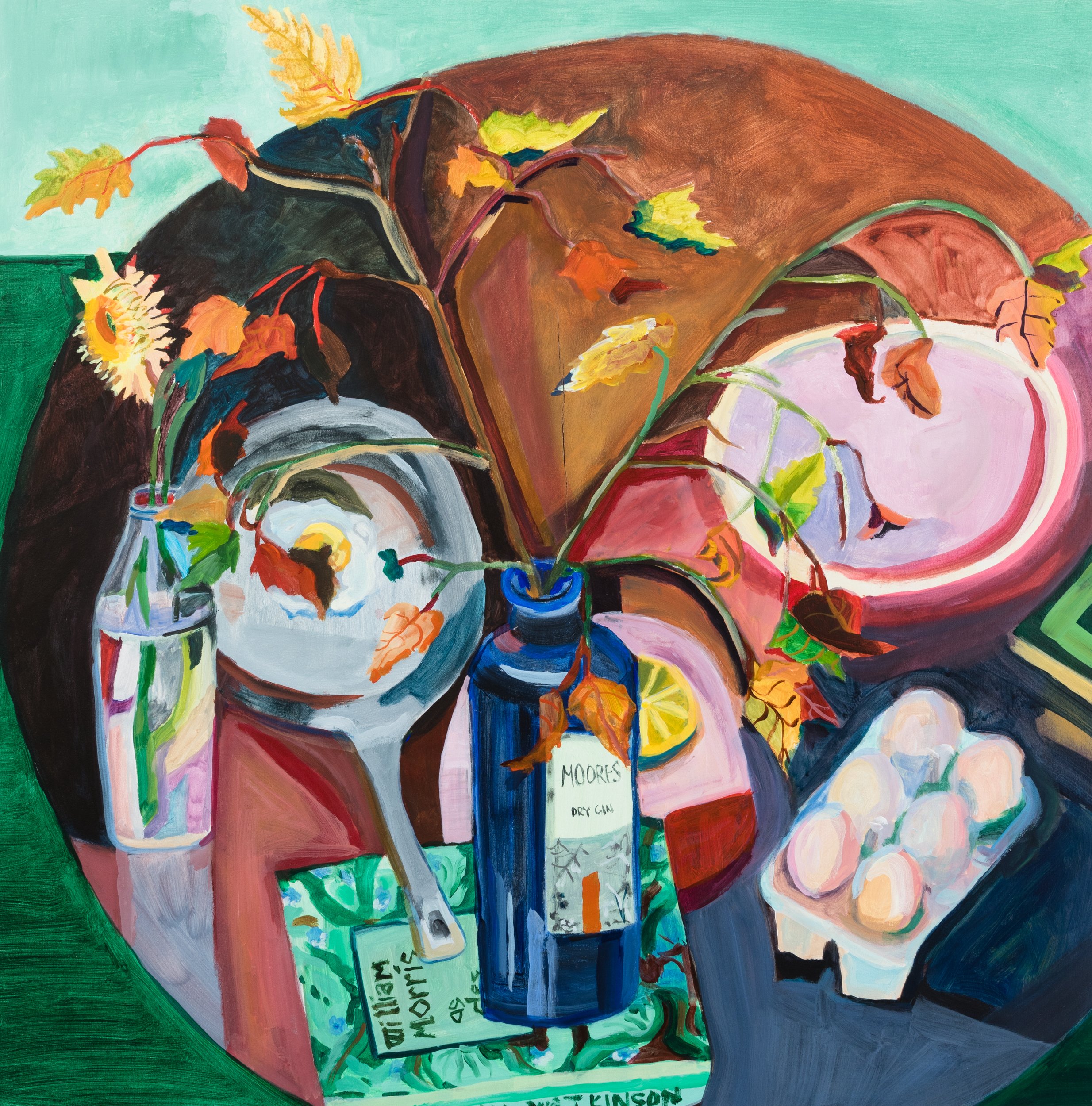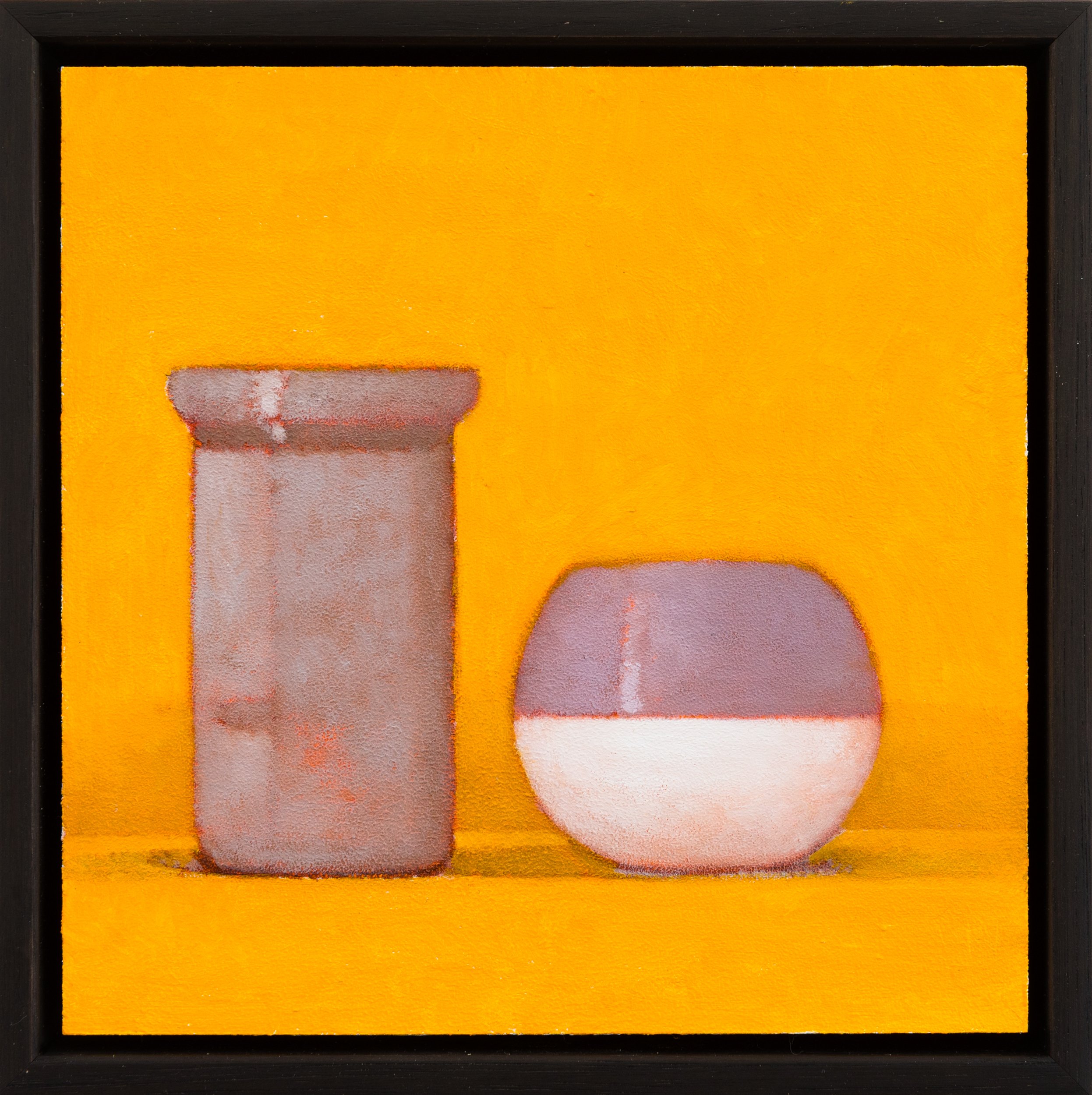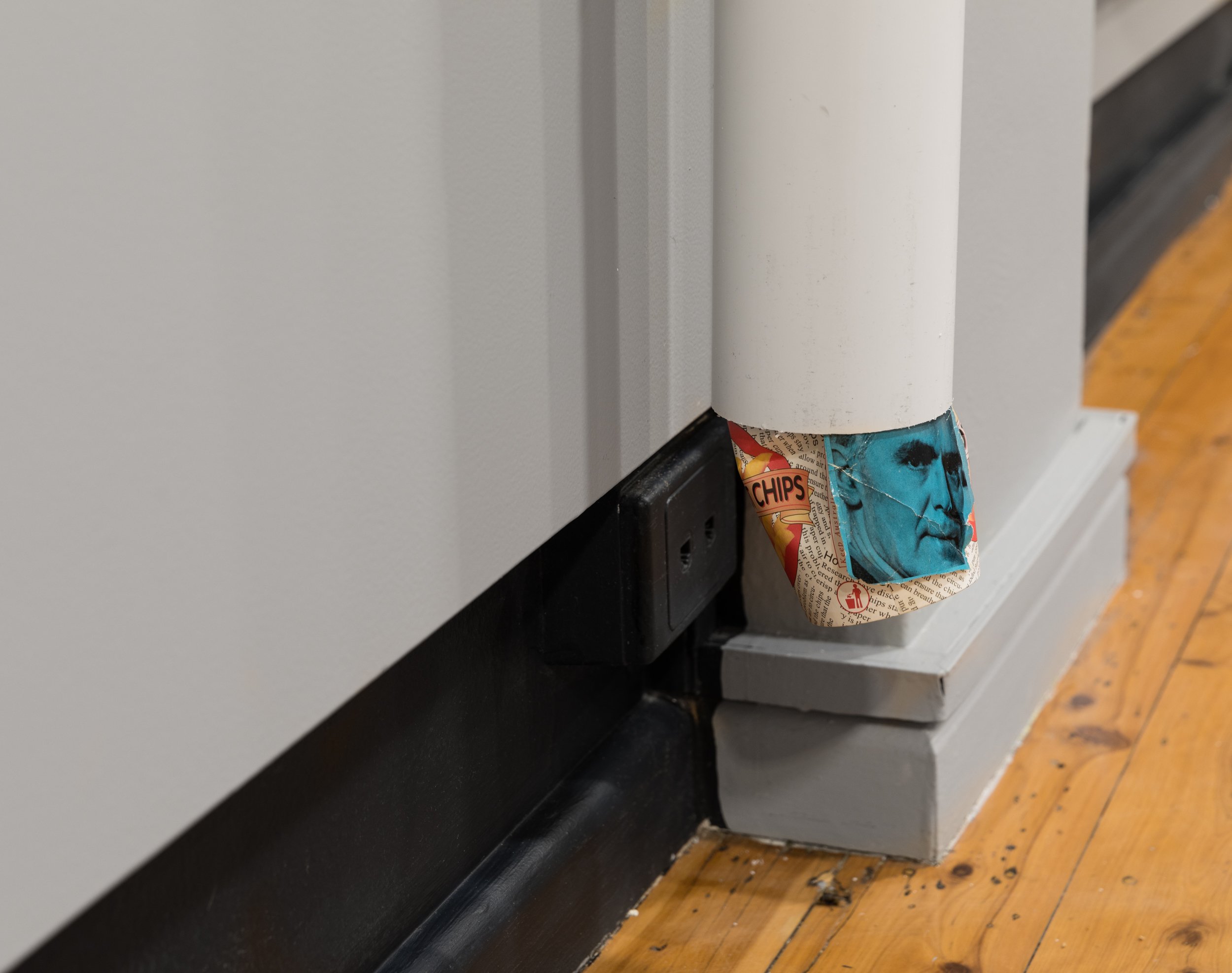
Christopher Zanko | SWEET MISGIVINGS
In Sweet Misgivings, Christopher Zanko elevates the carved intricacy of his work with increasing surface complexity. He continues with a focus on the mid-20th century home where fibro or brick veneer geometry becomes an armature for all sorts of decorative features. In his paintings we first see the cubic structure neatly placed on the block. From there we may enjoy (as the artist does) all the textural shifts across roof tiling, stairs and gates, the formal gardens, the sculptures and paving stones. Each painting represents a cultural world. Cast concrete planters, conifers positioned like pillars on either side of an entrance, baroque and neo-classical sculptural additions. Ornament gives expression to stories of migration and cultural difference, in some cases also demonstrating the technical skill of an owner-builder (like the Terrazzo brought from southern Europe).
An array of stylistic expressions established a sense of home in a new country while recrafting a house plan to fit the needs of its residents. Zanko mirrors these construction techniques via his own set of tools and skills, carving surfaces or precisely masking up an area to lay out a texture, like formwork is used to frame up a driveway.
In her recent study of mid-20th century migrant housing in Melbourne, Mirjana Lozanovska notes the diaspora aesthetics of the period, describing “a distinct architecture evolving from the interaction between the dwelling habits of migrants that were transported and the material order and form of the detached house.” The modifications to these catalogue homes tell a story of the residents, their habits and their needs. This narrative detail was already evident in Zanko’s work but he has more recently made links with his own family’s history of migration. The paintings in the current show emerged in parallel to conversations with his father about the family’s arrival in Australia, via the United Kingdingom, as refugees from eastern Europe.
Sweet Misgivings sees a progression in the artist’s work from nostalgic taxonomy to a deeper study of character. Zanko enjoys “the way these houses built from a plan offer so much variation in character and story 60 or 70 years on.” The house and its block is a stage on which elements are all organised to suit the habits and relationships within the household. The paintings in this show are then another kind of stage that honours the varied cultural expressions this built form allowed for.
Christopher Zanko was a finalist in the 2020 Brett Whiteley prize and, significantly, the 2019 Wynne Prize. In 2020 he was part of a commissioning exhibition organised by Hazelhurst Arts Centre, “The Home”, that celebrated art deco residential design in Australia. Another great opportunity has been the recent 70th anniversary commission to paint Rose Seidler House for the Sydney Living Museum Collection. Zanko’s work can also be found in the Wollongong Art Gallery and University of Wollongong collections.
- Melody Willis
Prof. Mirjana Lozanovska presentation, “Migrant Housing. Architecture, Dwelling and Migration”, 21 Dec 2020 https://youtu.be/jVdzX0Y_kyA (accessed 16 October 2021)
Lozanovska, Mirjana 2019 Migrant Housing: Architecture, Dwelling, Migration, Routledge

Scott Duncan | EMPTY VESSELS
In Scott Duncan’s ceramics, references from mid-century modern to antiquity fuse together through the firing process. Playful in construction and ambiguous in function, aesthetic histories adhere and then peel off like a turned up edge of corrugate cardboard. With a capacity to conjure the texture of an Italian Bitossi Ceramiche object or a local Bendigo Pottery vase, Scott Duncan pulls our focus to the echo of ancient forms in modern design. Antiquity stares back in the suggestion of an Etruscan face cut out of the side of a fruit box, the mouth inviting a hand to enter it. Duncan’s hand built forms might also suggest delicate perfume bottles with glass stoppers, while offering a scale that is as resilient as a Roman wine amphora.
On technique, Scott Duncan approaches things with a punk aesthetic. He has an idea of what he wants to achieve and then figures out how to make it work. Remarkably, each object is a single piece of earthenware. Shifts in texture, colour and gloss are achieved during the firing process. The artist makes his own dry underglazes, manufacturing chalk and his own pencils to create the idiosyncratic lines that mark the surface. Backing up the last five years of dedicated art making is his lengthy experience as a head chef. Downplaying the skill involved in ceramics, Duncan states, “It’s like making a cake,” before adding, “Porcelain clay is kind of like shortcrust pastry.” The production ethic and decisiveness of a chef is certainly evident in these pieces.
For the current show, Empty Vessels, Scott Duncan has ramped up the scale and constructed what he describes as a “mid-century monolith” of stacked forms. Saturn is a centrepiece of nostalgic modernist references looping back to a Greek myth origin story. Duncan’s Saturn ravenously expresses an enthusiastic appetite for the designed world high and low, from archaeological dig to a 1970s lounge room.
Scott Duncan grew up in Warrnambool on the south coast of Victoria at a time when the pathways offered for young men spanned football, farming or surfing. So he surfed and commenced art study locally with teacher Glenn Morgan. After recommencing his art practice, a residency at Kil.n.it Experimental Ceramics Studios in Glebe, Sydney, has connected him with an audience interested in ambitious work in clay. Empty Vessels is the artist’s first solo show at The Egg & Dart Gallery, Thirroul.
- Melody Willis

Darren Munce | DISCOORDINATED
Darren Munce offers up an ambiguous surface, the result of erasure, adjustment and slippage. Optical effects disintegrate with emergent geometries that scumble to grey. Skilled paint application is shifted through the squeegee scrape, an orbital sander or a rip of tape. With a background in signwriting and graphics, the artist can be very technical but this methodical work is upended through an impulsive counterplay. Works are rested and then returned to, carrying the weight of time. The paintings end substantially with accretions of oil along the edges, their corners softened by wear.
In one work, a seductive geometry of cubes sits atop a dense texture rendered through chance. In another, a deeply scoured surface is punctuated by a matrix of sharp linework that continues to respond to the undulations beneath. A lattice weaves over and under while carving new shapes and casting shadows. Loose grids and a range of greys mediate striking colour, making it feel right for rich magenta to sit with scarlet and deep cadmium yellow. Lines of lemon and zinc white pierce through as traces of a pattern language that has been pushed back.
An art residency in Leipzig (supported by the Australia Council and Creative Victoria) gave early context to Darren Munce’s interest in the divergent histories of abstraction. Geometry and chance, exactness and imprecision – his work demonstrates how these dualities find their real definition on the painted surface. By negotiating conflicting tendencies, he locates a zone where abstract invention can emerge.
- Melody Willis
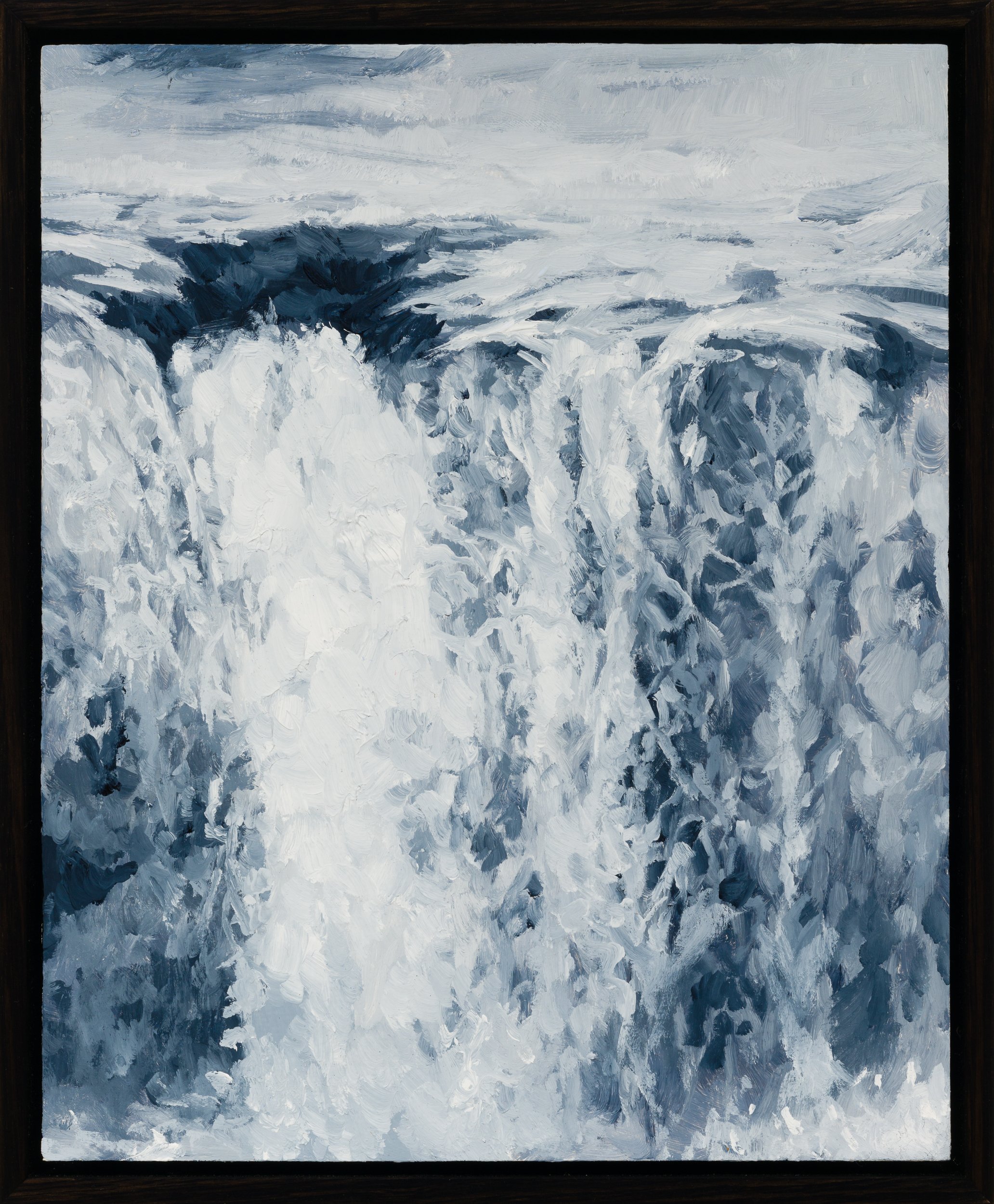
Madeleine Peters | NURSE OGILVIE'S BEDSHEETS
Madeleine Peters’ richly tonal oil paintings unlock fragmented narratives and expose time shifts, offering a sequence of compelling settings. In Nurse Ogilvie’s Bedsheets, Madeleine Peters makes visible female archetypes that are often sidelined – the working woman and the woman in a caring role. Through a practice of binding pictorial and verbal recollections, the images emerge as an instinctive response with an awareness of the limits of representation. She sees photo albums as serving as memory jolts, the images providing a touchstone for a more elaborate verbal recollection.
The artist speaks of “how people are held inside each other’s memories,” and in this instance she has gleaned tenderly from the life of her grandmother. The identity of Nurse Ogilvie is at the blurred edges of family memory, a woman working in a World War 2 field hospital and fondly remembered as “Fluffy” Ogilvie by the artist’s grandfather, a Royal Air Force Surgeon. With that entry point, the paintings move beyond any deliberate storytelling. The use of grey tone is a binding mechanism and the expression of fabric becomes metaphorical as it changes states – bedsheets gathered up against the sky, folded precisely or covering the breakfast table. When scattered on the beach the cloth responds to a jagged landscape and rolling clouds. The fold of the sheets signals the importance of detail, gesture and attention.
Madeleine Peters’ work acknowledges the gaps and false truths of any kind of image construction. Her paintings remain open for reading. We see a woman occupied in her carriage as the train pushes through the landscape, moving across territory, creating a non-place between motion and stasis. In another image, the boiled eggs offer a memory flash of an everyday breakfast, the mundane linked to the memorable – in this case, her grandmother’s recollection of the end of war.
Nurse Ogilvie’s Bedsheets offers historical context for a politics of care that has gained a new relevance. Madeleine Peters describes a practice of setting things right in her images and in this context, the bedsheets become a metaphor for a kind of psychological tidying. The alterations made in these paintings come with a kind of melancholic understanding that the past can never be reached. These are not portraits. The archetype moves in and out of visibility, at times a cipher, and then with such clarity as the memory of someone deeply loved.
- Melody Willis
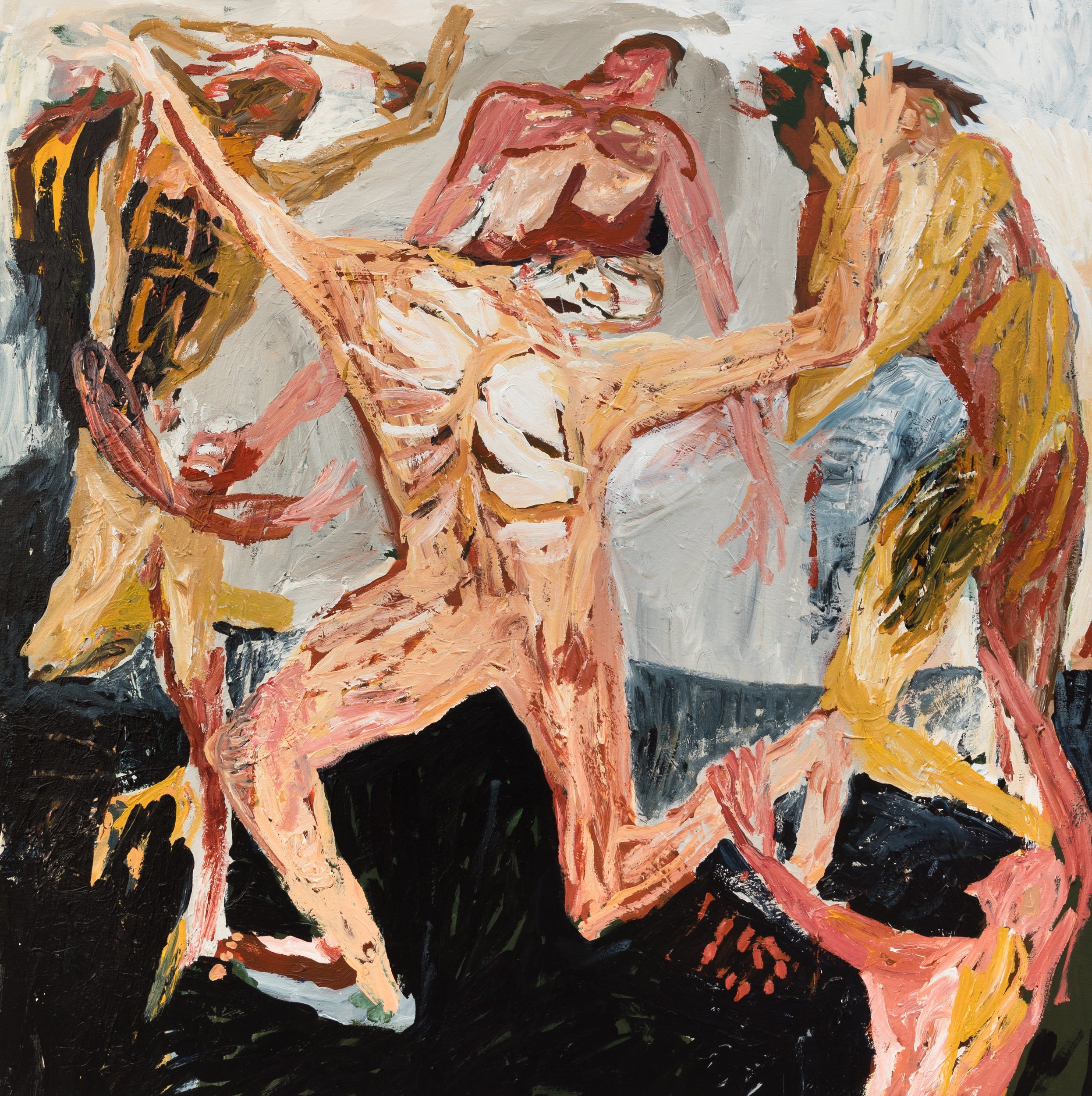
Georgia Spain | ONE TO ANOTHER
The more paintings that I make, the more I remind myself that it is in the process and not the outcome that meaning is found. The gesture of doing it, over and over and over. That one can find meaning in anything if one looks for it. The same painting can be about breakfast, or the lack of rainfall in a year, or the state of politics depending on how you look at it.
- Georgia Spain

Georgia Spain | ONE TO ANOTHER (Copy)
The more paintings that I make, the more I remind myself that it is in the process and not the outcome that meaning is found. The gesture of doing it, over and over and over. That one can find meaning in anything if one looks for it. The same painting can be about breakfast, or the lack of rainfall in a year, or the state of politics depending on how you look at it.
- Georgia Spain

Julia Flanagan | LIKINGNESS
Likingness brings the warmth and joy of Julia Flanagan’s work back to the Egg and Dart Gallery. The past year marks a progression to a vibrant new palette along with an increased complexity in the abstract language of her painting and sculpture. Through shapeshifting and layering references emerge – perhaps to a machine or the head of a figure, a flower or a passing thought – before resolving in an open state of potential.
Julia Flanagan has been in a larger home studio since the end of 2020. With its warm natural light, this new context is evident in the shift to lemon yellows and rich orange. The intensity is then tempered by the complementary counterparts of navy blue and deep green. The daily environment has a real influence on Flanagan’s processes and the events of the past year have increased that crossover between family life and creative practice. Well loved music, play time or her children’s words find a way into the work. I dreamed I was having a dream but the dream was no dream, a quote from her son, is a note on this interlocking dynamic between domestic experience and the studio.
With paintings raised on a platform, Flanagan generally works close to the surface. As viewers at that proximity we can also see the detail, decision making and alterations that have occurred. There is a plan, generally a drawing, and then the plan needs adjustment. References to essential architectural forms remain but the arches now link up and soften like theatre drapes. Three new sculptures, with the addition of perfect spheres in bright colours, suggest assemblages as a mechanism or prop. The artist forms pieces using an electric scroll saw, with some shapes needing to be hand cut. She then refers to her own drawings as she glues, clamps and constructs.
The linework in these paintings is more intricate, fascinated and layered. An almost impossible level of compression takes place in the trajectory of these stripes and shapes, but it succeeds. Flanagan offers an embracing quality of positivity, further supported by the show title, Likingness – a rarely used word suggesting unabashedly pleasant associations between things, all while floating around the deeper challenges of making work.
Julia Flanagan exhibited as part of Sydney Contemporary in 2020 as well as collaborating with fashion label Gorman. In 2019 she won the Georges River Sculpture Prize with the piece Everything I Own. The show Likingness is Flanagan’s second solo exhibition at the Egg & Dart.
- Melody Willis
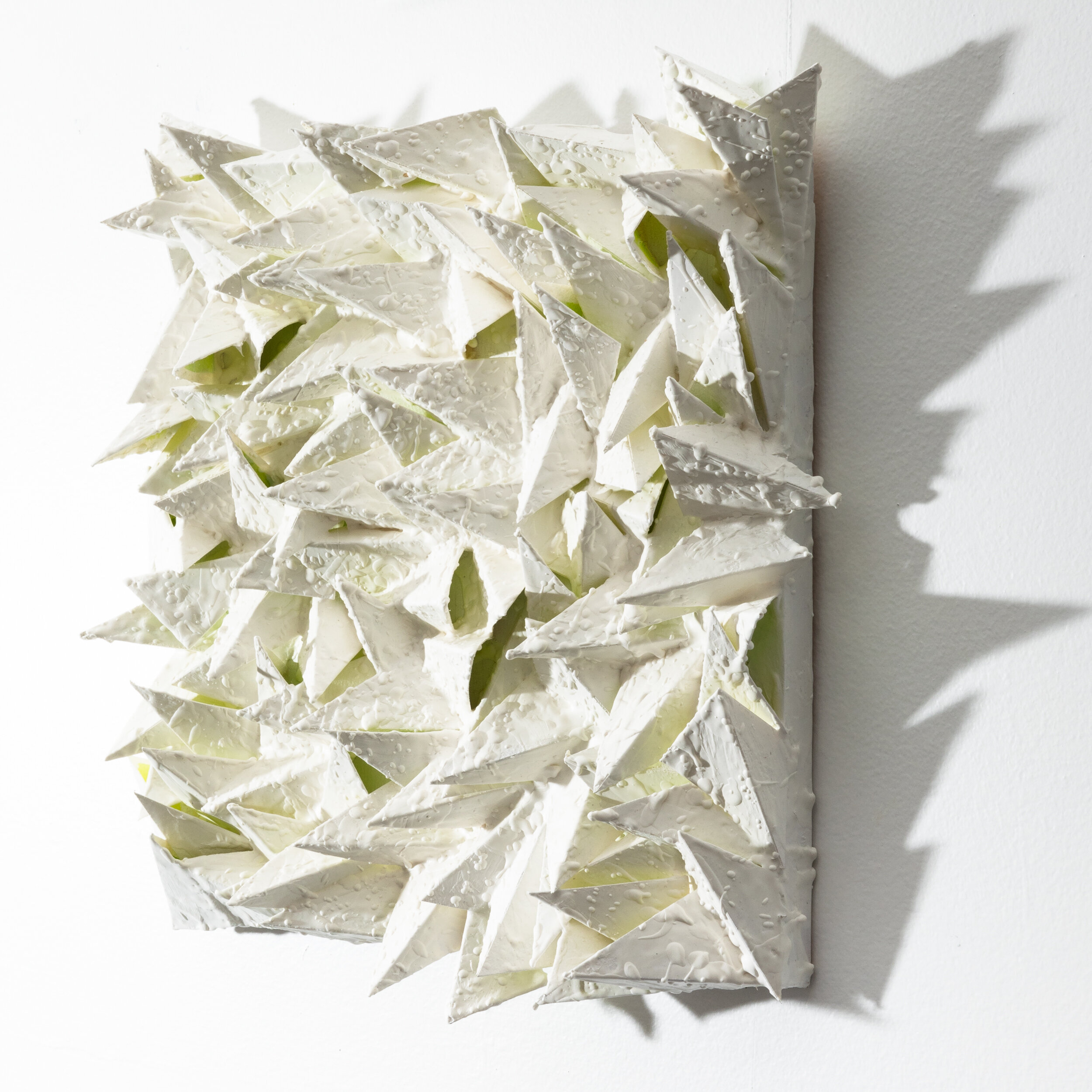
Gabrielle Adamik, Lee Bethel & Aaron Fell-Fracasso | MATERIALISTICS
In art theory, a trick of the eye is called trompe l’oeil and the purpose of this technique is to make the viewer believe they are seeing something when in fact, they are not. This visual effect is created through the mastery and manipulation of objects and materials, as well as the spaces they occupy. The key here, is the use of and experimentation with materials, rendered in ways that are not of the usual, a practice that unites artists Gabrielle Adamik, Lee Bethel and Aaron Fell-Fracasso. Materialistics is an exhibition that does not set out to trick the eye, but rather, to present familiar materials in unfamiliar ways.
In this exhibition, Gabrielle Adamik’s glass sculptures bring the unexpected to the forefront with their bold pairings of materials. These gestural works sit on the precipice of stability and fragility as smooth, glistening glass springs out of heavily flocked, recycled timber bases. Whilst the fine glass fronds reach out and interact with the space around them, the bases act as counterweights that anchor and steady the works. The outcome is an unexpected interaction of two processes and outcomes, with Adamik nudging her materials into delicate yet supportive arrangements.
An intimate relationship with material informs Lee Bethel’s practice and her resulting artworks are accounts of time, texture and dedication. This show presents Bethel’s works that have been made through the process of arranging hundreds of small pieces of hand ripped paper onto a backing board. The result is a vast landscape of contours through which the eye is invited to meander. Materialistics also gives the rare chance to see Lee Bethel’s sculptures which provide a continuation and development of the practice evident in her wall-mounted compositions.
Aaron Fell-Fracasso’s works offer the viewer a rich plane upon which are impressed a number of determined and purposeful landmarks. At first glance, there is a resulting uniformity to the artwork due to the use of a homogenous palette, however as the artwork allows the viewer time and space, an array of colours and textures emerge. By mixing sand with oil paint, Fell-Fracasso is able to sculpt the paint using tools both industrial and self-made. These sculpted ridges, smudges and scrapes have a familiar quality to them and infer, rather than make obvious the process by which they are made.
This is a group exhibition in which the focus is placed on the surface, texture and topography of an artwork. Materialistics is suggestive of a paring back to the essential elements of an artwork, to the careful selection and relationship between artist and medium, highlighting the way that material informs practice and vice versa.
- Eva Balog

India Mark | GOYA SODA
On a studio visit India Mark is wearing a soft green plaid skirt, a connection to the modulated grids that bring an innovative reading to her continuing still life project. In the new work, painted plaid interacts with harmoniously presented objects and stretches out behind lenses of water. The artist uses a digital program to generate her own patterns as a reference, but it is their transcription onto the surface through underpainting that radiates and enlivens these grids.
A key shift in this exhibition is a heightened intensity in the hues. Mark was challenged by the possibilities of colour through her discovery of posters by Redback Graphix, an Australian political print collective from the 1980s. On viewing these, her application of colour has increased in saturation while remaining closely attuned, demonstrating a real comprehension of light effects as she knocks back intense cerulean blue or cadmium orange with titanium white.
There are no initial personal attachments to the subjects India Mark paints. They are forms that promote deep observation through various light and textural effects. It is through time spent looking that the artist considers the vessels attain some value. “Now I am very attached to them.” In the studio, a number of items sit on a high shelf, more a collection of apothecary cannisters than her previous still life subjects of tea cup and saucer. “This is my favourite,” she says as she picks up a simple metal container before balancing it on top of a flat based egg cup. “I’ve got a thing about stacking.” Compiling the objects removes the function and brings the composition back to formal relationships. Picking up a small brown box, she notes that cubes are tricky. I wonder how this quite simple object might be a challenge but it is an indicator of the time Mark spends really looking and transcribing. Her paintings seek an exact measure through equilibrium and the ruled line, then softened by bevelled corners. Objects reverberate along their edges as they interpret an underlying structure.
Goya Soda is the name of the show and is also a song by French group Christine and The Queens. The two words contrast the intensity of Goya’s painting and the pop sparkle of soda water. The song is also about looking, with lyrics that state, “Who came there to see, who is seen.” India Mark’s new work aligns with both the pushing together of contrasts and the act of looping observation. In the studio she says, “What am I looking at? How do I break that down and paint it?” It is this demonstration of deep attentiveness which is of real appeal in India Mark’s ongoing project.
- Melody Willis

Nick Santoro, Scott Duncan & Henry Jock Walker | NICK, SCOTT & JOCK
Nick, Scott & Jock brings together the work of three artists exploring divergent materials through new approaches. Pen on paper, ceramics and abstract painting are well-traversed but Nick, Scott and Jock offer new takes on each, upturning conventions of form and technique.
The show is an opportunity to view Nick Santoro’s drawings separate from his paintings. These drawings have generally been initiated at a restaurant table or work desk rather than in the studio. Images are revisited and expanded on as an extended scrawl that brings Santoro’s universe of characters into black and white clarity. The landscape quality of his paintings fall away, replaced by densely textured psychological spaces inhabited by spectral pop entities and local identities.
This exhibition marks Scott Duncan’s debut at the Egg & Dart. With a broad approach to ceramics, these are composite objects of real technical complexity. Playful in construction and ambiguous in function, the works feel egalitarian and open-ended. Assemblage performs as collage and references from modernity and classicism fuse together through the firing process. Aesthetic histories adhere and then peel off. It’s an invitation to consider the iteration of these forms through time or to just enjoy the convergence of allusions.
Henry Jock Walker merges abstraction with unexpected materials. Collected used wetsuits are cut, arranged and stitched together to act as a memorial of time spent in the ocean. The detailed crafting of these works tests the rigid masculinity seen historically in both abstract painting and surf culture. With irreverence and mobility, Jock continues his overall challenge to expected representations in art, commerce and sport.
- Melody Willis

Clare Thackway | BETWEEN US
Clare Thackway shows us how figurative painting can unveil the relationship of intimacy to distance. The space between bodies is an ongoing consideration explored through the use of drapery and the stripe, with these ideas now palpable in the context of a global pandemic. The cloth creates separation and a physical barrier but this can also be felt as an act of collective care. There is a tenderness in the works as they unfold aspects of the body in vulnerable states. These are intimate paintings that contemplate our anxieties around contagion and a health response that seeks to separate and demarcate. The sensation is made visceral in the paint method through aerosols projecting across the surface. It appear as glitches, spots and sprays – masking fluid on the base layer generating areas of vivid pink and yellow that abstract the visual field. The breath, an essential expression of life, now requires containment and management.
The artist relocated to Paris from the Illawarra, and the colour has shifted to evoke this quite extreme distance. The paintings are interiors but eucalyptus green and gold hues cast a landscape quality over the work and there is a dryness to the palette that suggests Australian conditions. The softer lilac tones comprehend the more subtle light found in the sky at dusk. The muted approach to this light then brings us into the northern hemisphere.
The fabric stripe is a fundamental pattern used by Thackway for both contemplation and compositional strategy. The thick bands fragment and distort the figure by introducing a false contour that twists to create illusion. The shifts in surface play a trick with perspective – are the bodies standing or in repose? Are we looking down or across? Is there a body there at all? Culturally the stripe also has fascinating evocations – for hazard or hygiene, freedom and confinement. The artist works with these fluid associations as a personal trope that allows her to explore psychological states and social dynamics.
Clare Thackway works with subjects she knows well and although these are not portraits there is an intense feeling of intimacy in the work. This is countered by the drape of fabric and painterly surface interruptions that acknowledge the spaces between us. Previously the cloth was employed by the artist to explore connection, but in this current time we may feel the masking of the body as a deliberate separation. The newly pictured intermediary space, no longer a void, contains splatters of paint – aerosols with anxious potential. The spots that float in the foreground suggest an invisible interrupting force. In this context the works make contact with the interdependence of our bodies, intricately linked while separated by borders and systems of control.
-Melody Willis

Mark Merrikin | WITH FARIES
With an instinctive meshing together of material and feel, Mark Merrikin’s paintings capture everyday connections between friends and family. This might feel like a well-trod path, but there is an unusual tenderness and direct gesture in the work. Figures feel lovingly embraced by a wild meshing of patterns and shifting surfaces. A colour link to the Fauvist modernists is there but then knocked back by accretions of cement and spray paint. Built up grainy areas bring the outside in to these images, landing the work in an urban present.
Merrikin uses direct methods to get started. Sketches are made from personal photographs and remembered conversations. An old-style overhead projector helps to get the drawings up onto the surface. This is where changes take place, swapping up images, adding and overlaying the composition while moving across the surface with paint and pencil and spray paint.
In parallel with the paintings, the artist presents casual sculptural objects in the same materials, incidental in their presentation but resilient in their physical weight. In these tender and confessional sculptures, portrait and dialogue find a foothold in what feels like a broken off piece of pavement. The objects further compress the space between urban exterior and the homestyle intimacy of the paintings. Merrikin works in an instinctive and direct way, with an intent to fold us in on moments of personal exchange.
Mark Merrikin is an emerging artist from Woolgoolga on the NSW mid-north coast. He is now based in Port Kembla, having graduated from the University of Wollongong. The Egg & Dart is excited to present the artist’s first show at the gallery.
- Melody Willis
Georgia Spain | BOTH WAYS IS THE ONLY WAY I WANT IT
Georgia Spain lives and works in Sandford Tasmania. Since her first solo exhibition with the Egg & Dart in April 2020, (Beginning in Blue) Left in Red, the response has been overwhelming. In September 2020 Georgia Spain was awarded the winner of The Brett Whiteley Travelling Scholarship and featured in The Egg & Dart’s online presentation for Sydney Contemporary 2020. In Spain’s paintings, physical connection is explored through bodies in groupings. Each work touches on an instinctual engagement between people in crisis or communion.

Ebony Eden | AN ORCHID YEAR
Ebony Eden offers a meditation on shifting social aesthetics where personal expression emerges through the arrangement and nurturing of plants and objects. Eden uses a parallel drawing method to generate spaces of domestic garden utopia. There is no firm vanishing point or point of view but instead a presentation of infinite arrangement and possibility. There is a lightness in the work and a fluidity in her visual language. Working with lines in parallel, we can perceive depth and scale on this parallel axis as she move from still life to garden landscape.
By using a grid, a form of measure stabilises the work. Pictured as creamy white bricks or tiles with blue pointing that suggests an architectural drafting pencil, the grid either floats or forms the structure of a wall, a pool, a tiled ground. Freehand but surprisingly measured, the grid suggests a dream design proposal. Using acrylic on board, depth is described through the layering of shapes and surface and there is minimal cast shadow. Instead, we might perceive this depth as a background pattern seen through holes in a cheese plant.
The domestic gardens of inner south Sydney are another source for Eden’s work. Here again, plants are sculptural features presented against varying surfaces and structures. Patternlike aggregate concrete may be easy to hose or sweep, but it also offers a contrasting aesthetic backdrop to the sculptural planting contained within.
With the indoor plant, the garden has come inside. It could even be that the new popularity of indoor plants is linked to the rise in apartment living. Plants are sold or exchanged –transferred in tins to be repotted or sent soil-free in the post. In internet culture, the trade in plants can have an hot house quality. Bids are high for particular specimens. To communicate scale, plants are pictured alongside everyday objects (a beer bottle, a ruler). Here Eden finds an expression of absurd aesthetics combined with practicality. Eden’s titles affirm these improvised associations between objects – “crate plinth”, “low maintenance garden”, “shelf or shelves”.
The plant specimens in Eden’s studio are gleaned from online auctions or cuttings exchanged between friends. They grow there among paintings in progress and other collections of geology and found form. She brings these arrangements into her studio and her painted world, a means to organise and explore the cultural dynamics between plants, objects and human sensibilities. There is an edge of uncertainty in the works which allows for flexible thinking. These are proposals for spaces and arrangements. Nothing is really quite fixed and in that there is space for thinking.
Ebony Eden has a background in printmaking from the National Art School. Eden presented a major installation as part of the show Here + Now at the Wollongong Art Gallery in 2018. She has also exhibited in numerous group shows since 2013. This is her first solo exhibition at The Egg & Dart.
- Melody Willis


Nick Santoro | LIBIDNAL HYMNAL
Nick Santoro’s universe might be a strategy for figuring out the dimensions of capitalism. In an offhand way, the expression Libidinal Hymnal certainly suggests that. And it is a state the late punk thinker Mark Fisher proposed as a kind of entrapment: a political model that leaves little room to dream beyond its own consumptive desires. Acquisition and personal expression might be paramount, but it’s pretty fun right? And Santoro offers us a populated grab bag where outcasts and winners launch into speculative encounters in a slippery dimension between local realism and the internet realm. (For example, TESLA’s cybertruck confronts the Bindle Bros in a George Soros network of grey pipes located in youtube’s blind spots.)
The artist doesn’t talk this way though. His associations are easy permutations, not quite this-goes-with-that, but a hypothetical practice where the works propose open-ended scenarios. The space of the painting suggests a theatre stage with the artist presenting as producer/director. The decorative frames might even act as a definitive curtain. One significant work, a cut out of the artist’s profile, is a nod to this role as “producer”, a piss-take acknowledgement of the figurative painter as a puppet master.
While Santoro’s studio and computer offer a collage of reference points and diversions, there are no didactic politics to be found. Santoro does mention the documentary Hypernormalisation, Adam Curtis’s densely delivered analysis of the global political landscape from the 1980s onward. But it could be that the artist aligns himself with the jumpy editing and pushed together aesthetic of this film, which guides us from Jane Fonda workouts via Ronald Reagan’s astrological decision making to the billionaire factories of the present.
A more clearly political element in the current show is Santoro’s workplace drawings. These have been constructed while working at a front desk, doing the kind of part-time monitoring job that allows for an art practice. Here drawing has become a parallel kind of labour embedded within that which is paid by the hour. In Santoro’s drawings there is the same detail as seen in the paintings but stripping away colour and surface allows for a richer linear expression. This linearity has then found its way back into recent paintings, where figures are elevated through outline, acquiring an aura of celebrity or transcendence.
Nick Santoro was this year a finalist in the Archibald Prize with his painting of fellow artist Phanos Proestos. The painting “Hewitts Avenue Montage” was exhibited in the John Sulman Prize in 2019 and his work was presented at Melbourne Art Fair 2020 and Sydney Contemporary in 2019. A recent significant installation formed part of Here + Now at the Wollongong Art Gallery near the end of 2018. Santoro was born in 1994 and lives in the Illawarra area.
-Melody Willis



